- BBVA Dashboard
- Financials
- Filings
- Holdings
- Transcripts
- ETFs
-
Insider
- Institutional
- Shorts
-
6-K Filing
Banco Bilbao Vizcaya Argentaria (BBVA) 6-KCurrent report (foreign)
Filed: 27 Apr 23, 8:05am
UNITED STATES SECURITIES AND EXCHANGE
COMMISSION
WASHINGTON, D.C. 20549
FORM 6-K
REPORT OF FOREIGN ISSUER PURSUANT TO RULE 13a-16 OR 15d-16
UNDER THE SECURITIES EXCHANGE ACT OF 1934
For the month of April, 2023
Commission file number: 1-10110
BANCO BILBAO VIZCAYA ARGENTARIA, S.A.
(Exact name of Registrant as specified in its charter)
BANK BILBAO VIZCAYA ARGENTARIA, S.A.
(Translation of Registrant’s name into English)
Calle Azul 4,
28050 Madrid
Spain
(Address of principal executive offices)
Indicate by check mark whether the registrant files or will file annual reports under cover of Form 20-F or Form 40-F:
Form 20-F X Form 40-F
Indicate by check mark if the registrant is submitting the Form 6-K in paper as permitted by Regulation S-T Rule 101(b)(1):
Yes No X
Indicate by check mark if the registrant is submitting the Form 6-K in paper as permitted by Regulation S-T Rule 101(b)(7):
Yes No X

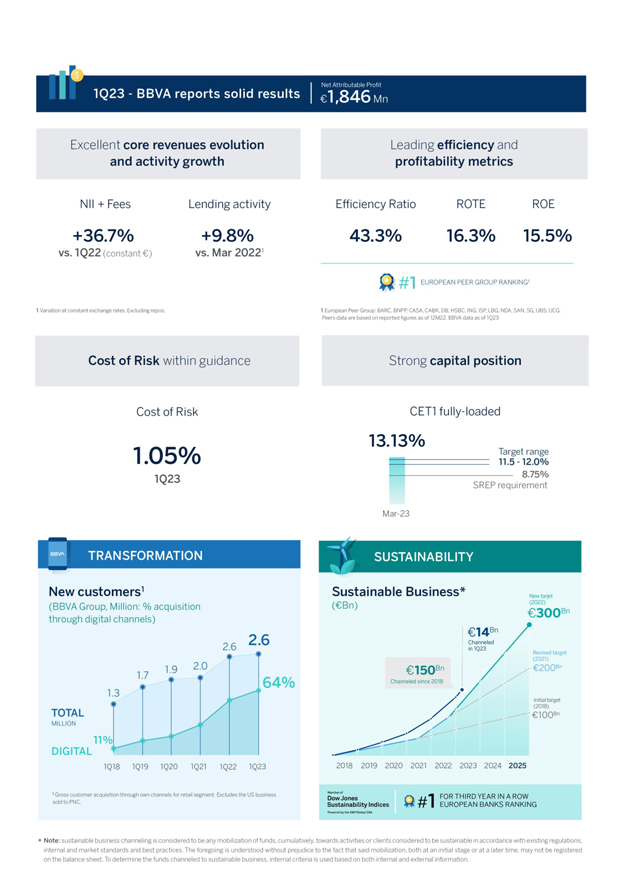
|
Main data
| BBVA GROUP MAIN DATA (CONSOLIDATED FIGURES) | ||||||||||||||||||||||||||||
| 31-03-23 | Δ % | 31-03-22 | 31-12-22 | |||||||||||||||||||||||||
| Balance sheet (millions of euros) | ||||||||||||||||||||||||||||
| Total assets | 739,564 | 9.5 | 675,706 | 712,092 | ||||||||||||||||||||||||
| Loans and advances to customers (gross) | 373,481 | 8.0 | 345,970 | 368,588 | ||||||||||||||||||||||||
| Deposits from customers | 395,880 | 9.6 | 361,195 | 394,404 | ||||||||||||||||||||||||
| Total customer funds | 556,839 | 9.5 | 508,439 | 544,576 | ||||||||||||||||||||||||
| Total equity | 51,471 | 5.4 | 48,847 | 50,517 | ||||||||||||||||||||||||
| Income statement (millions of euros) | ||||||||||||||||||||||||||||
| Net interest income | 5,642 | 43.1 | 3,943 | 19,124 | ||||||||||||||||||||||||
| Gross income | 6,958 | 29.0 | 5,395 | 24,743 | ||||||||||||||||||||||||
| Operating income | 3,942 | 31.9 | 2,989 | 14,042 | ||||||||||||||||||||||||
| Net attributable profit (loss) | 1,846 | 39.4 | 1,325 | 6,358 | ||||||||||||||||||||||||
| Net attributable profit (loss) excluding non-recurring impacts (1) | 1,846 | 39.4 | 1,325 | 6,559 | ||||||||||||||||||||||||
| The BBVA share and share performance ratios | ||||||||||||||||||||||||||||
| Number of shares issued (million) | 6,030 | (9.6) | 6,668 | 6,030 | ||||||||||||||||||||||||
| Share price (euros) | 6.57 | 26.1 | 5.21 | 5.63 | ||||||||||||||||||||||||
| Adjusted earning (loss) per share (euros) (1) | 0.29 | 37.4 | 0.21 | 1.04 | ||||||||||||||||||||||||
| Earning (loss) per share (euros) (1) | 0.29 | 52.5 | 0.19 | 0.98 | ||||||||||||||||||||||||
| Book value per share (euros) (1) | 8.02 | 15.1 | 6.97 | 7.78 | ||||||||||||||||||||||||
| Tangible book value per share (euros) (1) | 7.65 | 15.3 | 6.64 | 7.43 | ||||||||||||||||||||||||
| Market capitalization (millions of euros) | 39,624 | 14.1 | 34,740 | 33,974 | ||||||||||||||||||||||||
| Dividend yield (dividend/price; %) (1) (2) | 5.3 | 2.7 | 6.2 | |||||||||||||||||||||||||
| Significant ratios (%) | ||||||||||||||||||||||||||||
| Adjusted ROE (net attributable profit (loss)/average shareholders’ funds +/- average accumulated other comprehensive income) (1) | 15.5 | 12.1 | 14.4 | |||||||||||||||||||||||||
| Adjusted ROTE (net attributable profit (loss)/average shareholders’ funds excluding average intangible assets +/- average accumulated other comprehensive income) (1) | 16.3 | 12.6 | 15.1 | |||||||||||||||||||||||||
| Adjusted ROA (profit (loss) for the period / average total assets - ATA) (1) | 1.11 | 0.81 | 0.99 | |||||||||||||||||||||||||
| Adjusted RORWA (profit (loss) for the period / average risk-weighted assets - RWA) (1) | 2.36 | 1.72 | 2.12 | |||||||||||||||||||||||||
| Efficiency ratio (1) | 43.3 | 44.6 | 43.2 | |||||||||||||||||||||||||
| Cost of risk (1) | 1.05 | 0.82 | 0.91 | |||||||||||||||||||||||||
| NPL ratio (1) | 3.3 | 4.0 | 3.4 | |||||||||||||||||||||||||
| NPL coverage ratio (1) | 82 | 76 | 81 | |||||||||||||||||||||||||
| Capital adequacy ratios (%) | ||||||||||||||||||||||||||||
| CET1 fully-loaded | 13.13 | 12.70 | 12.61 | |||||||||||||||||||||||||
| CET1 phased-in (3) | 13.13 | 12.81 | 12.68 | |||||||||||||||||||||||||
| Total ratio phased-in (3) | 16.30 | 16.82 | 15.98 | |||||||||||||||||||||||||
| Other information | ||||||||||||||||||||||||||||
| Number of active customers (million) | 68.3 | 9.8 | 62.2 | 67.3 | ||||||||||||||||||||||||
| Number of shareholders | 786,031 | (3.6) | 815,233 | 801,216 | ||||||||||||||||||||||||
| Number of employees | 116,923 | 5.0 | 111,402 | 115,675 | ||||||||||||||||||||||||
| Number of branches | 6,051 | (0.3) | 6,071 | 6,040 | ||||||||||||||||||||||||
| Number of ATMs | 29,882 | 1.7 | 29,379 | 29,807 | ||||||||||||||||||||||||
(1) For more information, see Alternative Performance Measures at the end of this report.
(2) Calculated by dividing the dividends paid in the last twelve calendar months by the closing price of the period.
(3) Phased-in ratios include the temporary treatment on the impact of IFRS 9, calculated in accordance with Article 473 bis amendments of the Capital Requirements Regulation (CRR), introduced by the Regulation (EU) 2020/873. As of March 31, 2023, there are no differences between phased-in and fully-loaded ratios due to the aforementioned temporary treatment.
| 4 | ||||
| 9 | ||||
| 10 | ||||
| 10 | ||||
| 16 | ||||
| 18 | ||||
| 20 | ||||
| 25 | ||||
| 28 | ||||
| 31 | ||||
| 34 | ||||
| 38 | ||||
| 43 | ||||
| 46 | ||||
| 47 | ||||
| 50 | ||||
Cover photograph by Pedro González Ortiz.
| 4 |
Results and business activity
The BBVA Group generated a net attributable profit of €1,846m in the first quarter of 2023, which represents an increase of 39.4% compared to the first quarter of the previous year, driven by the performance of recurring income from the banking business, mainly net interest income.
These results include the recording, for the financial year 2023, of the temporary tax on credit institutions and financial credit institutions for €225m, included in the other operating income and expenses line of the income statement.
Operating expenses increased by 25.4% at Group level, largely impacted by the inflation rates observed in the countries in which the Group operates. Notwithstanding the above, thanks to the remarkable growth in gross income, higher than the growth in expenses, the efficiency ratio stood at 43.3% as of March 31, 2023, with an improvement of 241 basis points, in constant terms, compared to the ratio recorded 12 months earlier, placing BBVA, once again, in a leading position among its European peer group1.
The provisions for impairment on financial assets increased (+28.9% in year-on-year terms and at constant exchange rates), with higher provisions mainly in South America and Mexico, in a context of growth in activity.
Loans and advances to customers grew by 1.4% compared to the end of December 2022, strongly favored by the evolution of retail loans (+2.9% at Group level).
Customer funds increased by 2.3% compared to the end of December 2022, thanks to the good performance of off-balance sheet funds (+7.2%), also linked to increased customer preference for them.
LOANS AND ADVANCES TO CUSTOMERS AND TOTAL CUSTOMER FUNDS (VARIATION COMPARED TO 31-12-2022)
|
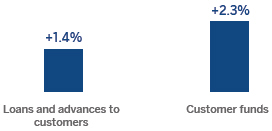
Business areas
As for the business areas, excluding the effect of currency fluctuation in those areas where it has an impact, in each of them it is worth mentioning:
| – | Spain generated a net attributable profit of €541m in the first quarter of the year 2023, 9.5% lower than in the same period of the previous year, due to the recording, on January 1, 2023, of the temporary tax on credit institutions and financial credit institutions for €225m. |
| – | In Mexico, BBVA achieved a net attributable profit of €1,285m by the end of the first quarter of 2023, representing an increase of 44.2% compared to the same period in 2022, mainly as a result of the boost in lending activity and improvement in the customer spread, which translated into significant growth in net interest income and, to a lesser extent, fee and commission income. |
| – | Turkey generated a net attributable profit of €277m in the first quarter of 2023, which compares very positively with the negative result of €76m in the same quarter of 2022, both periods reflecting the impact of the application of hyperinflation accounting. The accumulated result at the end of March 2023 reflects, in addition to the good business dynamics, the positive impact of the revaluation for tax purposes of the real estate and other depreciable assets of Garanti BBVA AS which has generated a credit in corporate income tax expense, due to the higher tax base of the assets, amounting to approximately €260m. |
| – | South America generated a cumulative net attributable profit of €184m at the end of the first quarter of the year 2023, which represents a year-on-year variation of +57.2%, mainly due to the outstanding performance of recurring income (+70.3%) and NTI, which comfortably offset the growth of expenses, in a highly inflationary environment throughout the region, and the higher provisioning requirements for impairment on financial assets. |
| – | Rest of Business achieved a net attributable profit of €92m accumulated at the end of the first quarter of 2023, 11.6% higher than in the same period of the previous year, thanks to a favorable performance of recurring income and NTI, which offset the increase in expenses in a context of higher inflation and a normalization of loan-loss provisions. |
1 European peer group: Barclays, BNP Paribas, Crédit Agricole, Caixabank, Deutsche Bank, HSBC, ING, Intesa Sanpaolo, Lloyds Banking Group, Nordea, Banco Santander, Société Générale, UBS and Unicredit, comparable peer data as of the end of December 2022.
| 5 |
The Corporate Center recorded a net attributable profit of €-531m in the first quarter of the year 2023, compared with €-215m recorded in the same period of the previous year, mainly due to a negative contribution in the NTI line from exchange rate hedges as a result of better than expected currency performance, in particular the Mexican peso.
Lastly, and for a broader understanding of the Group’s activity and results, supplementary information is provided below for the wholesale business carried out by BBVA, Corporate & Investment Banking (CIB), in the countries where it operates. CIB generated a net attributable profit of €550m in the first quarter of 2023. These results, which do not include the application of hyperinflation accounting, represent an increase of 28.1% on a year-on-year basis, due to the growth in recurring income and NTI, which comfortably offset the higher expenses and provisions for impairment on financial assets, highlighting the contribution of Global Transactional Banking.
NET ATTRIBUTABLE PROFIT (LOSS) (MILLIONS OF EUROS) |
NET ATTRIBUTABLE PROFIT BREAKDOWN (1) (PERCENTAGE. 1Q23) | |||
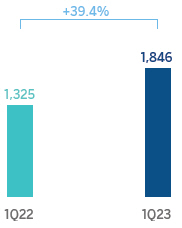 |
| |||
| (1) Excludes the Corporate Center. |
Liquidity
The availability of substantial liquidity buffers in each of the geographical areas in which the BBVA Group operates and their management, have allowed internal and regulatory ratios to be maintained well above the minimums required.
Solvency
The Group’s CET1 fully-loaded ratio stood at 13.13% as of March 31, 2023, maintaining a large management buffer over the Group’s CET1 requirement (8.75%), and also above the Group’s established target management range of 11.5-12.0% of CET1.
Shareholder remuneration
Regarding shareholder remuneration, as approved by the General Shareholders’ Meeting on March 17, 2023, in its first item on the agenda, on April 5, 2023, a cash payment of €0.31 gross per each outstanding BBVA share entitled to receive such amount was made against the 2022 results, as an additional shareholder remuneration for the financial year 2022. Thus, the total amount of cash distributions for 2022, taking into account the €0.12 gross per share that was distributed in October 2022, amounted to €0.43 gross per share.
Total shareholder remuneration includes, in addition to the cash payments mentioned above, the extraordinary remuneration resulting from the execution of BBVA’s buyback program for the repurchase of own shares announced on February 1, 2023 for a maximum amount of €422m. On April 21, 2023, BBVA announced the completion of this share buyback program, having acquired 64,643,559 BBVA shares between March 20 and April 20, 2023, representing approximately 1.1% of BBVA’s share capital as of said date.
IFRS 17 - Insurance contracts
Replacing the International Financial Reporting Standard IFRS 4, on January 1, 2023 IFRS 17 entered into force for the recognition of insurance contracts, which requires establishing January 1, 2022 as the transition date, implying a restatement of the comparative financial statements from that transition date.
The impact of the entry into force of IFRS 17 on the financial statements of the BBVA Group has not been significant.
| 6 |
Sustainability
Channeling sustainable business
SUSTAINABLE BUSINESS BREAKDOWN (PERCENTAGE. TOTAL AMOUNT CHANNELED 2018-MARCH 2023)
|
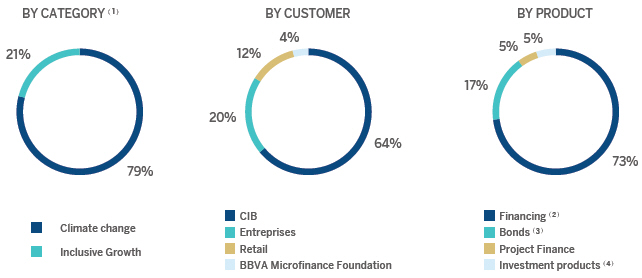
(1) In those cases where it is not feasible or there is not enough information available to allow an exact distribution between the categories of climate change and inclusive growth, internal estimates are made based on the information available.
(2) Non-Project Finance and transactional banking activity.
(3) Bonds in which BBVA acts as bookrunner.
(4) Investment products art. 8 or 9 under Sustainable Finance Disclosure Regulation (SFDR) or similar criteria outside the European Union, managed, intermediated or marketed by BBVA. Includes, in Retail: structured deposits, insurance policies for electric vehicles and self-renting of electric vehicles, mainly; and in CIB and Enterprise: structured deposits, mainly.
BBVA has mobilized a total of approximately €150 billion in sustainable business between 2018 and March 2023. Close to €14 billion have been mobilized this quarter, which represents an increase of nearly 20% compared to the same period in 2022.
Within the channeling of sustainable business2 accumulated between 2018 and March 2023 which aims to promote the fight against climate change, what stands out is the contribution of the financing of sustainable projects, distinct from project finance and transactional banking activity, which represents 78% of the total channeled at the end of March 2023. It should be considered that these products have had a normal rate of amortization since the beginning of their channeling. The intermediation of third-party bonds in which BBVA acts as bookrunner, a business activity that is recorded off-balance sheet, represents 18% of the channeled business linked to the fight against climate change. Lastly, investment funds and other off-balance sheet products such as insurance and pension plans represent 4%.
For its part, within the channeling of sustainable business accumulated between 2018 and March 2023 which aims to promote inclusive growth, the financing of sustainable projects, financing other than project finance and transactional banking activity, represent 58% of the total amount channeled at the end of March 2023, showing a normal rate of amortization since the beginning of its channeling. The intermediation of third-party bonds in which BBVA acts as bookrunner represents 14%, while investment funds and other off-balance sheet products such as insurance and pension plans represent 8%. Finally, the activity of the BBVA Microfinance Foundation (FMBBVA), not recorded on the BBVA Group’s balance sheet, whose objective is to support entrepreneurs with microcredits, represents 20% in terms of the purpose of promoting inclusive growth.
During the first quarter of 2023, the good performance of the retail business has continued, highlighting the mobilization related to sustainable mobility, such as the acquisition of hybrid or electric vehicles, which has grown by 26% compared to the same quarter of the previous year, activity in which geographical areas such as Turkey, Mexico and Peru multiply by more than two times the mobilization compared to the same period of 2022. In financing for inclusive growth, one of the activities that stands out the most is the mobilization for entrepreneurship, which has grown by 15% compared to the same quarter of the previous year and where Turkey more than doubles the mobilization of the same quarter of the previous year.
In commercial business (enterprises), financing related to energy efficient buildings stands out, such as the developer loans or energy efficiency measures for buildings, where channeling grew by 50% in relation to the same quarter of the previous year and where Spain has been fundamental by increasing its channeling in this line by 57%.
2 Channeling sustainable business is considered to be any mobilization of financial flows, cumulatively, towards activities or clients considered sustainable in accordance with existing regulations, both internal and market standards and best practices. The foregoing is understood without prejudice to the fact that said mobilization, both initially and at a later time, may not be recorded on the balance sheet. To determine the amounts of channeled sustainable business, internal criteria based on both internal and external information are used.
| 7 |
Lastly, in the corporate business, the dynamism of the brokered bond market in which BBVA acts as bookrunner stands out. During this quarter, the mobilization related to intermediation of these bonds has experienced an increase of 102% compared to the same quarter last year, mainly driven by the greater volume of green bonds, an activity that stands out with an increase of 103% compared to the same quarter of the previous year. However, this first quarter has also been marked by signs of a slowdown in the sustainable corporate financing market, both in the long and short term.
Relevant advances in sustainability matters
| • | TCFD |
BBVA has published its fourth TCFD (Task Force on climate-related financial disclosure) report this quarter. As this is its fourth report, BBVA has been one of the first banks to incorporate several of the recommendations of the Glasgow Financial Alliance for Net Zero Emissions (GFANZ) to draw up a plan of transition, a crucial element to facilitate a better understanding of how the Group approaches the transition towards a low carbon economy. New features include the creation of the BBVA Sustainability Alignment Steering Group, which will monitor the objectives and transition plans of its clients.
| • | Publication of the progress in the decarbonization of the BBVA portfolios |
BBVA is committed to aligning its activity with a scenario of zero net emissions in 2050. To this end, it supports its customers with financing, advice and innovative solutions, and it is monitoring its customers’ decarbonization strategies and incorporating them into its tools of evaluating risks. BBVA follows operational indicators that are relevant in the transformation to obtain a prospective and individualized vision of each client.
During this quarter, BBVA has published for the first time in its TCFD report the progress made in its commitment to decarbonize its credit portfolio, publishing details of the sector plans in which alignment objectives have been set: oil and gas, electricity generation, autos, steel and cement; or phase-out targets, as in the case of the coal sector. In the oil and gas sector, according to the Net Zero Banking Alliance (NZBA) recommendations, progress must be reported 12 months after the date the target is set. BBVA set them in October 2022. For this reason, in this sector it has not published this follow-up at the moment. In all sectors in which progress has been published, there have been cumulative reductions in all decarbonization indicators, although progress is not expected to be linear in the short term.
| 2030 ALIGNMENT TARGETS AND EMISSIONS ALLOCATED (banking activity) | ||||||||||||||||||
| Sector and metric | 2020 (1) | 2022 | 2020 (1) - 2030 target | % progress 2022 | Emissions allocated associated with the value chain (M t CO2e) (2) | |||||||
| Oil & Gas M t CO2e (1) | 14 | — | (30)% | n/a | n/a | ||||||
| Power kg CO2e/Mwh | 221 | 212 | (52)% | (4.0)% | 3.5 | ||||||
| Autos g CO2/v-km | 205 | 195 | (46)% | (4.8)% | 0.77 | ||||||
| Steel kg CO2/t Steel | 1,270 | 1,140 | (23)% | (10.2)% | 0.82 | ||||||
| Cement kg CO2 /t Cement | 700 | 690 | (17)% | (1.4)% | 0.31 | ||||||
| Coal (3) Total commitment (€M) | 1,701 | 0.31 | |||||||||
n/a: not applicable
(1) Oil & Gas baseline year 2021.
(2) The calculation of the attributed emissions associated with the value chain has been carried out by adding all the emissions from the different NACE sectors of the sectors under analysis. These NACE sectors comprise more sectors than those included in the PACTA calculation since PACTA is only calculated on the point in the value chain where most of the emissions are generated. This calculation is carried out in this way because, based on the PACTA methodology, it is assumed that by aligning the part of the value chain responsible for emissions, the sector as a whole is aligned. The calculation has been carried out using the PCAF methodology and includes the emissions of BBVA.S.A. except Portugal branches.
(3) Phase-out 2030 in developed countries and 2040 globally.
| 8 |
| • | Progress in energy efficiency products in Spain |
BBVA has launched a personalized digital solution for clients in collaboration with a large energy company, for the installation of solar panels in residential homes together with a media campaign. The solution allows private customers to simulate the installation of solar panels at home, both in single-family homes and in communities of owners, with information on potential savings in electricity, the subsidies that could be applied for and financing with advantageous conditions.
During this quarter, BBVA has financed a total of approximately 4,000 panel installations with a growth of more than 67% compared to the first quarter of 2022.
| • | Sustainability training for suppliers |
BBVA has promoted sustainability training among 252 of its SME suppliers. With this, BBVA extends to suppliers cross-sectoral sustainability training that its employees have already received since 2020. This initiative is part of the United Nations Compact Sustainable Suppliers training program.
| • | BBVA Asset Management recognized with the Best Sustainability Team Award |
BBVA Asset Management has received the award for the Best Sustainability Team of a Spanish Manager at the Funds People Awards 2023. This represents the recognition of the implementation of its Global Sustainability Plan started in 2020, its adherence to UNPRI and the Net Zero Asset Managers in 2021, and the announcement in 2022 of its initial objectives of decarbonization of its portfolios.
| 9 |
Global growth has shown resilience and has generally been higher than expected by analysts, despite the moderating trend in recent quarters.
Economic activity has benefited from the surprisingly rapid decline in energy prices following the sharp increase observed after the outbreak of the war in Ukraine, as well as from the process of normalization of global supply chains and the dynamism of labor markets, which have contributed to the relative strength of private consumption and the service sector. In addition, the easing of anti-COVID-19 policies in China has contributed to a more gradual than expected slowdown in growth, despite its initial negative impact on activity.
Lower energy prices and improvements in bottlenecks in production processes have contributed to a reduction in headline inflation, which, in annual terms, reached 5.0% in the United States and 6.9% in the Eurozone in March. However, despite the recent slowdown in headline inflation, measures of underlying inflation continue to show no significant improvement.
Against this backdrop of still elevated inflationary pressures, central banks have continued to tighten monetary conditions, causing tensions in the banking sector and increasing financial volatility, which eased more recently, following decisive actions taken by authorities in Europe and the United States and in line with the perception that the problems in the banking sector are not systemic.
Despite the recent turmoil in the banking sector, which has contributed to a further tightening of financial conditions, reducing to some extent the pressure for additional monetary tightening, central banks have remained focused on reducing inflation. The U.S. Federal Reserve and the European Central Bank (ECB) have raised their benchmark interest rates (refinancing rates in the case of the ECB) to, respectively, 5.00% and 3.50% in March.
Although uncertainty is high, policy rates are likely to continue rising in the short term, to around 5.25% in the United States and 4.00% in the Eurozone, and to remain at these levels at least until the end of the year. In addition, central banks in both regions are expected to continue to reduce their balance sheets and address stress in the banking sector through macroprudential measures.
BBVA Research expects global growth to be 2.8% in 2023 (0.5 percentage points higher than the previous forecast), after reaching 3.2% in 2022 and 6.1% in 2021. Recent activity data and fading supply shocks favor an upward revision of GDP forecasts for 2023 to 0.8% in the United States and 0.6% in the Eurozone (respectively 0.3 and 0.7 percentage points higher than previously forecast), while in China growth this year is most likely to be 5.2%, 0.2 percentage points above the previous forecast mainly due to the positive impact of the easing of anti-COVID-19 policies. Also, despite the upward revisions, the outlook for a slowdown in global growth remains, in a context where financial volatility is expected to remain relatively high and interest rates and inflation are expected to remain at higher than expected levels for a longer period.
Uncertainty remains high and a number of factors could determine the materialization of more negative scenarios than the one forecast by BBVA Research. In particular, persistently high inflation and interest rates could generate a deep and widespread recession, as well as new episodes of financial volatility.
| 10 |
The BBVA Group generated a net attributable profit of €1,846m in the first quarter of 2023, which represents an increase of 39.4% compared to the first quarter of the previous year, driven by the performance of recurring income from the banking business, mainly net interest income.
These results include the recording, for the financial year 2023, of the temporary tax on credit institutions and financial credit institutions3 for €225m, included in the other operating income and expenses line of the income statement.
CONSOLIDATED INCOME STATEMENT (MILLIONS OF EUROS)
| ||||||||||||||||
| Δ % at constant | ||||||||||||||||
| 1Q23 | Δ % | exchange rates | 1Q22 | |||||||||||||
Net interest income | 5,642 | 43.1 | 43.3 | 3,943 | ||||||||||||
Net fees and commissions | 1,439 | 15.4 | 15.8 | 1,247 | ||||||||||||
Net trading income | 438 | (24.4) | (18.7) | 580 | ||||||||||||
Other operating income and expenses | (561) | 49.9 | 18.3 | (374) | ||||||||||||
Gross income | 6,958 | 29.0 | 32.7 | 5,395 | ||||||||||||
Operating expenses | (3,016) | 25.4 | 25.7 | (2,406) | ||||||||||||
Personnel expenses | (1,551) | 25.2 | 26.4 | (1,238) | ||||||||||||
Other administrative expenses | (1,127) | 31.8 | 31.9 | (855) | ||||||||||||
Depreciation | (339) | 8.3 | 6.0 | (313) | ||||||||||||
Operating income | 3,942 | 31.9 | 38.6 | 2,989 | ||||||||||||
Impairment on financial assets not measured at fair value through profit or loss | (968) | 31.4 | 28.9 | (737) | ||||||||||||
Provisions or reversal of provisions | (14) | (71.0) | (68.2) | (48) | ||||||||||||
Other gains (losses) | (16) | n.s. | n.s. | 20 | ||||||||||||
Profit (loss) before tax | 2,944 | 32.3 | 42.3 | 2,225 | ||||||||||||
Income tax | (950) | 5.1 | 10.7 | (903) | ||||||||||||
Profit (loss) for the period | 1,994 | 50.9 | 64.6 | 1,321 | ||||||||||||
Non-controlling interests | (148) | n.s. | n.s. | 3 | ||||||||||||
Net attributable profit (loss) | 1,846 | 39.4 | 40.5 | 1,325 | ||||||||||||
Adjusted earning (loss) per share (euros) (1) | 0.29 | 0.21 | ||||||||||||||
Earning (loss) per share (euros) (1) | 0.29 | 0.19 | ||||||||||||||
General note: 2022 figures have been restated according to IFRS17 - Insurance contracts.
(1) Adjusted by additional Tier 1 instrument remuneration. For more information, see Alternative Performance Measures at the end of this report.
3 In compliance with Law 38/2022, of December 27, which establishes the obligation to pay a patrimonial benefit of a public and non-taxable nature during the years 2023 and 2024 for credit institutions that operate in Spanish territory whose sum of total interest income and fee and commission income corresponding to the year 2019 is equal to or greater than €800m.
| 11 |
| CONSOLIDATED INCOME STATEMENT: QUARTERLY EVOLUTION (MILLIONS OF EUROS) | ||||||||||||||||||||||||
| 2023 | 2022 | |||||||||||||||||||||||
| 1Q | 4Q | 3Q | 2Q | 1Q | ||||||||||||||||||||
Net interest income | 5,642 | 5,334 | 5,252 | 4,595 | 3,943 | |||||||||||||||||||
Net fees and commissions | 1,439 | 1,328 | 1,385 | 1,413 | 1,247 | |||||||||||||||||||
Net trading income | 438 | 269 | 573 | 516 | 580 | |||||||||||||||||||
Other operating income and expenses | (561) | (443) | (372) | (501) | (374) | |||||||||||||||||||
Gross income | 6,958 | 6,489 | 6,838 | 6,022 | 5,395 | |||||||||||||||||||
Operating expenses | (3,016) | (2,875) | (2,803) | (2,618) | (2,406) | |||||||||||||||||||
Personnel expenses | (1,551) | (1,547) | (1,471) | (1,344) | (1,238) | |||||||||||||||||||
Other administrative expenses | (1,127) | (990) | (993) | (935) | (855) | |||||||||||||||||||
Depreciation | (339) | (338) | (338) | (340) | (313) | |||||||||||||||||||
Operating income | 3,942 | 3,614 | 4,035 | 3,404 | 2,989 | |||||||||||||||||||
| Impairment on financial assets not measured at fair value through profit or loss | (968) | (998) | (940) | (704) | (737) | |||||||||||||||||||
Provisions or reversal of provisions | (14) | (50) | (129) | (64) | (48) | |||||||||||||||||||
Other gains (losses) | (16) | (6) | 19 | (3) | 20 | |||||||||||||||||||
Profit (loss) before tax | 2,944 | 2,559 | 2,985 | 2,634 | 2,225 | |||||||||||||||||||
Income tax | (950) | (850) | (1,005) | (680) | (903) | |||||||||||||||||||
Profit (loss) for the period | 1,994 | 1,709 | 1,980 | 1,954 | 1,321 | |||||||||||||||||||
Non-controlling interests | (148) | (146) | (143) | (120) | 3 | |||||||||||||||||||
Net attributable profit (loss) excluding non-recurring impacts | 1,846 | 1,563 | 1,838 | 1,834 | 1,325 | |||||||||||||||||||
Discontinued operations and Other (1) | — | — | — | (201) | — | |||||||||||||||||||
Net attributable profit (loss) | 1,846 | 1,563 | 1,838 | 1,633 | 1,325 | |||||||||||||||||||
Adjusted earning (loss) per share (euros) (2) | 0.29 | 0.25 | 0.29 | 0.29 | 0.21 | |||||||||||||||||||
Earning (loss) per share (euros) (2) | 0.29 | 0.24 | 0.28 | 0.24 | 0.19 | |||||||||||||||||||
General note: 2022 figures have been restated according to IFRS17 - Insurance contracts.
(1) Includes the net impact arisen from the purchase of offices in Spain in the second quarter of 2022 for €-201m.
(2) Adjusted by additional Tier 1 instrument remuneration. For more information, see Alternative Performance Measures at the end of this report.
Unless expressly indicated otherwise, to better understand the changes under the main headings of the Group’s income statement, the year-on-year rates of change provided below refer to constant exchange rates. When comparing two dates or periods in this report, the impact of changes in the exchange rates against the euro of the currencies of the countries in which BBVA operates is sometimes excluded, assuming that exchange rates remain constant. For this purpose, the average exchange rate of the currency of each geographical area of the most recent period is used for both periods, except for those countries whose economies have been considered hyperinflationary, for which the closing exchange rate of the most recent period is used.
The accumulated net interest income as of March 31, 2023 was higher than the previous year (+43.3%), with increase in all business areas due to the improvement in customer spread and higher performing loan volumes. Particularly noteworthy was the good evolution in Mexico, South America and Spain.
Positive evolution in the net fees and commissions line, which increased by 15.8% in the year due to favorable performance in payment systems and demand deposits. By business areas, Mexico and Turkey are particularly noteworthy.
| 12 |
NET INTEREST INCOME / AVERAGE TOTAL ASSETS (PERCENTAGE) |
NET INTEREST INCOME PLUS NET FEES AND COMMISSIONS (MILLIONS OF EUROS AT CONSTANT EXCHANGE RATES) | |||
|
|
| ||
| (1) At current exchange rates: +36.5%. | ||||
NTI recorded a year-on-year variation of -18.7% at the end of March 2023, due to the negative results recorded in this line in the Corporate Center and, to a lesser extent, in Spain, partially offset by the favorable evolution of this line in all other business areas.
The other operating income and expenses line accumulated a result of €-561m as of March 31, 2023, compared to €-374m in the previous year, mainly due to the €225m recorded in this line for the temporary tax on credit institutions and financial credit institutions for the year 2023. This has been partially offset by the good performance of the insurance business, especially in Mexico.
GROSS INCOME (MILLIONS OF EUROS AT CONSTANT EXCHANGE RATES) |
(1) At current exchange rates: +29.0%.
|
Year-over-year, operating expenses increased 25.7% at the Group level. This increase is largely impacted by the inflation rates observed in the countries in which the Group operates. On the one hand, they have been impacted by the measures implemented by the Group in 2023 to compensate the loss of purchasing power of the workforce and, on the other hand, by the impact of general expenses.
Notwithstanding the above, thanks to the remarkable growth in gross income (+32.7%), the efficiency ratio stood at 43.3% as of March 31, 2023, with an improvement of 241 basis points compared to the ratio recorded 12 months earlier. By areas, Mexico and South America recorded a favorable performance in terms of efficiency.
| 13 |
OPERATING EXPENSES (MILLIONS OF EUROS AT CONSTANT EXCHANGE RATES) |
| EFFICIENCY RATIO (PERCENTAGE) | ||
(1) At current exchange rates: +25.4%. | 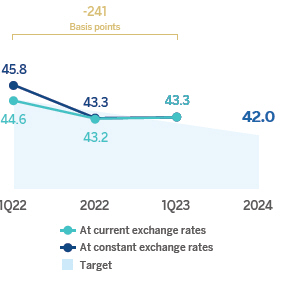 | |||
Impairment on financial assets not measured at fair value through profit or loss (impairment on financial assets) at the end of March 2023 was 28.9% higher than in the first quarter of the previous year, with higher provisions mainly in South America and Mexico, in a context of growth in activity.
OPERATING INCOME (MILLIONS OF EUROS AT CONSTANT EXCHANGE RATES) |
|
IMPAIRMENT ON FINANCIAL ASSETS (MILLIONS OF EUROS AT CONSTANT EXCHANGE RATES) | ||
(1) At current exchange rates: +31.9%. |
(1) At current exchange rates: +31.4%. | |||
The provisions or reversal of provisions line (hereinafter, provisions) accumulated a negative balance of €14m as of March 31, 2023, an improvement of 68.2% compared to the previous year, mainly due to lower provisions in Spain and Turkey.
For its part, the other gains (losses) line closed March 2023 with a balance of €-16m, which compares negatively with the previous year, when a positive balance of €20m was recorded mainly due to results related to real estate assets in Mexico, Spain and Turkey.
As a result of the above, the BBVA Group generated a net attributable profit, of €1,846m in the first quarter of the year 2023, which compares very positively with the same period of the previous year (+40.5%). These solid results were supported by the favorable evolution of net interest income and, to a lesser extent, net fees and commissions, which compensate higher operating expenses and the increase in provisions for impairment losses on financial assets.
The cumulative net attributable profits, in millions of euros, at the end of March 2023 for the business areas that compose the Group were as follows: €541m in Spain, €1,285m in Mexico, €277m in Turkey, €184m in South America and €92m in Rest of Business.
| 14 |
NET ATTRIBUTABLE PROFIT (LOSS) (MILLIONS OF EUROS AT CONSTANT EXCHANGE RATES) |
(1) At current exchange rates: +39.4%.
|
The Group’s excellent performance in 2022 has also allowed it accelerate value creation, as reflected in the growth of the tangible book value per share and dividends, which at the end of the first quarter of 2023 was 21.7% higher than in the same period of the previous year.
TANGIBLE BOOK VALUE PER SHARE (1) AND DIVIDENDS (EUROS) |
ADJUSTED EARNING (LOSS) PER SHARE (2) AND EARNING (LOSS) PER SHARE (2) (EUROS) | |||
| 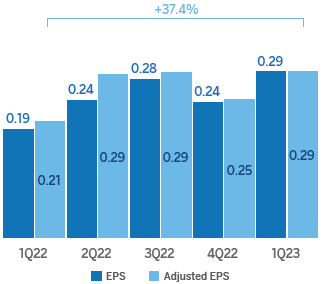 | |||
General note: replenishing dividends paid in the period. |
General note: adjusted EPS excludes the net impact arisen from the purchase of offices in Spain in 2Q22.
| |||
(1) For more information, see Alternative Performance Measures at the end of this report.
(2) Adjusted by additional Tier 1 instrument remuneration. For more information, see Alternative Performance Measures at the end of this report.
| 15 |
The Group’s profitability indicators improved in year-on-year terms, supported by the favorable performance of results.
ROE AND ROTE (1) (PERCENTAGE)
|
ROA AND RORWA (1) (PERCENTAGE)
| |||
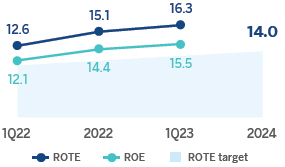 | 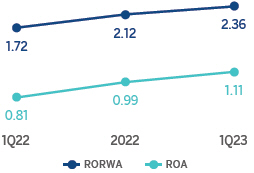 | |||
(1) The ratio at the end of 2022 excludes the net impact arisen from the purchase of offices in Spain.
| 16 |
Balance sheet and business activity
The most relevant aspects related to the evolution of the Group’s balance sheet and business activity as of March 31, 2023 are summarized below:
| – | Loans and advances to customers grew by 1.4% compared to the end of December 2022, strongly favored by the evolution of retail loans (+2.9% at Group level), supported by the good performance of both credit cards and consumer loans (+6.2% overall at Group level) in Mexico and Turkey and, to a lesser extent, by the good evolution of mortgage loans in Mexico. |
| – | Customer funds increased by 2.3% compared to the end of December 2022, thanks to the good performance of off-balance sheet funds (+7.2%), also linked to increased customer preference for them, particularly mutual funds in Mexico and Spain. For its part, customer deposits remained stable compared to the end of the previous year (+0.4%), with a reduction in demand deposits in Spain, offset by an increase in time deposits in Turkey and, to a lesser extent, in South America. |
CONSOLIDATED BALANCE SHEET (MILLIONS OF EUROS)
| ||||||||||||||||
| 31-03-23 | Δ % | 31-12-22 | 31-03-22 | |||||||||||||
Cash, cash balances at central banks and other demand deposits | 83,267 | 4.4 | 79,756 | 70,937 | ||||||||||||
Financial assets held for trading | 119,877 | 8.3 | 110,671 | 112,131 | ||||||||||||
Non-trading financial assets mandatorily at fair value through profit or loss | 7,227 | 4.9 | 6,888 | 6,625 | ||||||||||||
Financial assets designated at fair value through profit or loss | 997 | 9.2 | 913 | 1,036 | ||||||||||||
Financial assets at fair value through accumulated other comprehensive income | 66,277 | 1.4 | 65,374 | 71,079 | ||||||||||||
Financial assets at amortized cost | 427,259 | 3.1 | 414,421 | 381,838 | ||||||||||||
Loans and advances to central banks and credit institutions | 22,256 | 8.9 | 20,431 | 16,750 | ||||||||||||
Loans and advances to customers | 362,317 | 1.4 | 357,351 | 334,553 | ||||||||||||
Debt securities | 42,686 | 16.5 | 36,639 | 30,536 | ||||||||||||
Investments in joint ventures and associates | 920 | 0.4 | 916 | 911 | ||||||||||||
Tangible assets | 8,945 | 2.4 | 8,737 | 7,628 | ||||||||||||
Intangible assets | 2,209 | 2.4 | 2,156 | 2,056 | ||||||||||||
Other assets | 22,586 | 1.5 | 22,259 | 21,465 | ||||||||||||
Total assets | 739,564 | 3.9 | 712,092 | 675,706 | ||||||||||||
Financial liabilities held for trading | 107,185 | 12.1 | 95,611 | 85,960 | ||||||||||||
Other financial liabilities designated at fair value through profit or loss | 11,309 | 6.9 | 10,580 | 9,761 | ||||||||||||
Financial liabilities at amortized cost | 542,326 | 2.5 | 529,172 | 504,940 | ||||||||||||
Deposits from central banks and credit institutions | 75,109 | 15.1 | 65,258 | 73,161 | ||||||||||||
Deposits from customers | 395,880 | 0.4 | 394,404 | 361,195 | ||||||||||||
Debt certificates | 54,586 | (1.5) | 55,429 | 53,540 | ||||||||||||
Other financial liabilities | 16,751 | 19.0 | 14,081 | 17,045 | ||||||||||||
Liabilities under insurance and reinsurance contracts | 11,010 | 8.7 | 10,131 | 9,620 | ||||||||||||
Other liabilities | 16,263 | 1.1 | 16,081 | 16,577 | ||||||||||||
Total liabilities | 688,093 | 4.0 | 661,575 | 626,859 | ||||||||||||
Non-controlling interests | 3,680 | 1.6 | 3,623 | 5,510 | ||||||||||||
Accumulated other comprehensive income | (16,195) | (8.2) | (17,642) | (14,109) | ||||||||||||
Shareholders’ funds | 63,986 | (0.9) | 64,535 | 57,446 | ||||||||||||
Total equity | 51,471 | 1.9 | 50,517 | 48,847 | ||||||||||||
Total liabilities and equity | 739,564 | 3.9 | 712,092 | 675,706 | ||||||||||||
Memorandum item: | ||||||||||||||||
Guarantees given | 55,042 | (0.3) | 55,182 | 48,891 | ||||||||||||
General note: 2022 figures have been restated according to IFRS17 - Insurance contracts.
| 17 |
LOANS AND ADVANCES TO CUSTOMERS (MILLIONS OF EUROS)
|
| |||||||||||||||||||||||||||
| 31-03-23 | Δ % | 31-12-22 | 31-03-22 | |||||||||||||||||||||||||
| Public sector | 21,752 | 4.2 | 20,884 | 20,517 | ||||||||||||||||||||||||
| Individuals | 161,346 | 2.9 | 156,838 | 149,936 | ||||||||||||||||||||||||
Mortgages | 91,999 | 0.5 | 91,569 | 92,598 | ||||||||||||||||||||||||
Consumer | 37,663 | 4.7 | 35,965 | 32,845 | ||||||||||||||||||||||||
Credit cards | 18,997 | 9.3 | 17,382 | 13,326 | ||||||||||||||||||||||||
Other loans | 12,687 | 6.4 | 11,921 | 11,168 | ||||||||||||||||||||||||
| Business | 177,168 | (0.1) | 177,374 | 160,785 | ||||||||||||||||||||||||
| Non-performing loans | 13,215 | (2.1) | 13,493 | 14,731 | ||||||||||||||||||||||||
Loans and advances to customers (gross) | 373,481 | 1.3 | 368,588 | 345,970 | ||||||||||||||||||||||||
Allowances (1) | (11,164) | (0.7) | (11,237) | (11,417) | ||||||||||||||||||||||||
Loans and advances to customers | 362,317 | 1.4 | 357,351 | 334,553 | ||||||||||||||||||||||||
(1) Allowances include valuation adjustments for credit risk throughout the expected residual life in those financial instruments that have been acquired (mainly originating from the acquisition of Catalunya Banc, S.A.). As of March 31, 2023, December 31, 2022 and March 31, 2022, the remaining amount was €173m, €190m and €245m, respectively.
LOANS AND ADVANCES TO CUSTOMERS (BILLIONS OF EUROS) | CUSTOMER FUNDS (BILLIONS OF EUROS) | |||
(1) At constant exchange rates: +0.8%. |
| |||
(1) At constant exchange rates: +1.7%. | ||||
CUSTOMER FUNDS (MILLIONS OF EUROS)
|
| |||||||||||||||||||||||||||
| 31-03-23 | Δ % | 31-12-22 | 31-03-22 | |||||||||||||||||||||||||
| Deposits from customers | 395,880 | 0.4 | 394,404 | 361,195 | ||||||||||||||||||||||||
Current accounts | 308,918 | (2.3) | 316,082 | 301,333 | ||||||||||||||||||||||||
Time deposits | 83,516 | 10.4 | 75,646 | 58,649 | ||||||||||||||||||||||||
Other deposits | 3,446 | 28.8 | 2,676 | 1,213 | ||||||||||||||||||||||||
| Other customer funds | 160,959 | 7.2 | 150,172 | 147,244 | ||||||||||||||||||||||||
Mutual funds and investment companies and customer portfolios (1) | 118,640 | 8.9 | 108,936 | 106,323 | ||||||||||||||||||||||||
Pension funds | 38,901 | 0.6 | 38,653 | 38,460 | ||||||||||||||||||||||||
Other off-balance sheet funds | 3,418 | 32.4 | 2,582 | 2,461 | ||||||||||||||||||||||||
Total customer funds | 556,839 | 2.3 | 544,576 | 508,439 | ||||||||||||||||||||||||
(1) Includes the customer portfolios in Spain, Mexico, Colombia and Peru.
| 18 |
Capital base
The BBVA Group’s strong results during the quarter contributed to the consolidated CET1 fully-loaded ratio to reach 13.13% as of March 31, 2023, maintaining a large management buffer over the Group’s CET1 requirement (8.75%)4, and also above the Group’s established target management range of 11.5-12.0% of CET1.
During the first quarter of the year, the CET1 ratio increased 52 basis points. Profit generation, net of dividends and the remuneration of AT1 instruments, resulted in a contribution of 25 basis points to the CET1 ratio. Growth in risk-weighted assets (RWA) deducted 23 basis points from the CET1, which was partially offset by the effect of hyperinflation on equity, the positive evolution of market effect in CET1 and lower regulatory deductions. Additionally, it includes the reversal of the CET1 deduction for prudential provisioning of non-performing exposures, once it has been incorporated into the Group’s capital requirement, the impact of which was +19 basis points.
Fully-loaded risk-weighted assets (RWA) increased by approximately €11,700m in the quarter, mainly as a result of increased activity including also the expected regulatory and supervisory impacts.
The consolidated fully-loaded additional Tier 1 capital (AT1) stood at 1.49% as of March 31, 2023, resulting in a 5 basis point decrease from the previous quarter, mainly due to the increase in risk-weighted assets.
For its part, the consolidated fully-loaded Tier 2 ratio at the end of December stood at 1.68%, with a decrease of 11 basis points in the quarter. The total fully-loaded capital ratio stands at 16.30%.
It is worth mentioning that, with effect from January 1, 2023, the application of part of the transitional effects applied by the Group in the determination of the phased-in ratio has ended, so that as of March 31, 2023, this ratio coincides with the fully-loaded ratio.
| FULLY-LOADED CAPITAL RATIOS (PERCENTAGE) |
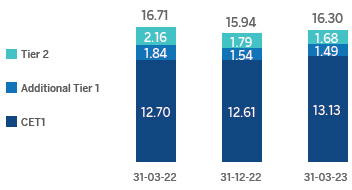 |
CAPITAL BASE (MILLIONS OF EUROS)
|
| |||||||||||||||||||||||
| CRD IV phased-in | CRD IV fully-loaded | |||||||||||||||||||||||
| 31-03-23 (1) (2) | 31-12-22 | 31-03-22 | 31-03-23 (1) (2) | 31-12-22 | 31-03-22 | |||||||||||||||||||
Common Equity Tier 1 (CET 1) | 45,761 | 42,738 | 40,537 | 45,761 | 42,484 | 40,154 | ||||||||||||||||||
Tier 1 | 50,948 | 47,931 | 46,364 | 50,948 | 47,677 | 45,982 | ||||||||||||||||||
Tier 2 | 5,865 | 5,930 | 6,839 | 5,865 | 6,023 | 6,838 | ||||||||||||||||||
Total capital (Tier 1 + Tier 2) | 56,813 | 53,861 | 53,203 | 56,813 | 53,699 | 52,819 | ||||||||||||||||||
Risk-weighted assets | 348,598 | 337,066 | 316,361 | 348,598 | 336,884 | 316,131 | ||||||||||||||||||
CET1 (%) | 13.13 | 12.68 | 12.81 | 13.13 | 12.61 | 12.70 | ||||||||||||||||||
Tier 1 (%) | 14.62 | 14.22 | 14.66 | 14.62 | 14.15 | 14.55 | ||||||||||||||||||
Tier 2 (%) | 1.68 | 1.76 | 2.16 | 1.68 | 1.79 | 2.16 | ||||||||||||||||||
Total capital ratio (%) | 16.30 | 15.98 | 16.82 | 16.30 | 15.94 | 16.71 | ||||||||||||||||||
(1) The difference between the phased-in and fully-loaded ratios arises from the temporary treatment of certain capital items, mainly of the impact of IFRS 9, to which the BBVA Group has adhered voluntarily (in accordance with article 473bis of the CRR and the subsequent amendments introduced by the Regulation (EU) 2020/873). As of March 31, 2023, there are no differences between phased-in and fully-loaded ratios due to the aforementioned temporary treatment.
(2) Preliminary data.
4 Includes the update of the countercyclical capital buffer calculated on the basis of exposure at end-December 2022.
| 19 |
Regarding shareholder remuneration, as approved by the General Shareholders’ Meeting on March 17, 2023, in its first item on the agenda, on April 5, 2023, a cash payment of €0.31 gross per each outstanding BBVA share entitled to receive such amount was made against the 2022 results, as an additional shareholder remuneration for the financial year 2022. Thus, the total amount of cash distributions for 2022, taking into account the €0.12 gross per share that was distributed in October 2022, amounted to €0.43 gross per share.
Total shareholder remuneration includes, in addition to the cash payments mentioned above, the extraordinary remuneration resulting from the execution of BBVA’s buyback program for the repurchase of own shares announced on February 1, 2023 for a maximum amount of €422m.
As of March 31, 2023, BBVA’s share capital stood at €2,954,757,116.36, divided into 6,030,116,564 shares, at €0.49 par value each, although, on March 20, 2023, after receiving the required authorization from the ECB, the Group began the execution of the aforementioned buyback program for the repurchase of own shares aimed at reducing BBVA’s share capital through the redemption of the shares acquired. On April 21, 2023, BBVA announced the completion of this share buyback program, having acquired 64,643,559 BBVA shares between March 20 and April 20, 2023, representing approximately 1.1% of BBVA’s share capital as of said date.
| SHAREHOLDER STRUCTURE (31-03-23) | ||||||||||||||||
| Shareholders | Shares issued | |||||||||||||||
| Number of shares | Number | �� | % | Number | % | |||||||||||
Up to 500 | 326,256 | 41.5 | 61,193,570 | 1.0 | ||||||||||||
501 to 5,000 | 359,832 | 45.8 | 639,344,983 | 10.6 | ||||||||||||
5,001 to 10,000 | 53,578 | 6.8 | 376,518,484 | 6.2 | ||||||||||||
10,001 to 50,000 | 41,760 | 5.3 | 797,609,653 | 13.2 | ||||||||||||
50,001 to 100,000 | 2,973 | 0.4 | 202,817,212 | 3.4 | ||||||||||||
100,001 to 500,000 | 1,359 | 0.2 | 245,800,790 | 4.1 | ||||||||||||
More than 500,001 | 273 | 0.03 | 3,706,831,872 | 61.5 | ||||||||||||
Total | 786,031 | 100 | 6,030,116,564 | 100 | ||||||||||||
With regard to MREL (Minimum Requirement for own funds and Eligible Liabilities) requirements, BBVA must maintain, from January 1, 2022, an amount of own funds and eligible liabilities equal to 21.46% of the total RWAs of its resolution group, at a sub-consolidated5 level (hereinafter, the “MREL in RWAs”). This MREL in RWAs does not include the combined capital buffer requirement which, according to applicable regulations and supervisory criteria, would currently be 3.30%. Given the structure of own funds and eligible liabilities of the resolution group, as of March 31, 2023, the MREL in RWAs ratio stands at 26.89%6,7, complying with the aforementioned requirement.
With the aim of reinforcing compliance with these requirements, BBVA has made a debt issue during the first quarter of 2023. For more information on this and other issues, see “Structural risks” section within the “Risk management”- chapter.
Lastly, as of March 31, 2023, the Group’s fully-loaded leverage ratio stood at 6.6% (6.6% phased-in)8.
Ratings
During the first quarter of 2023, BBVA’s rating has continued to show its strength and all agencies have maintained their rating in the A category. In March, DBRS communicated the result of its annual review of BBVA, affirming the rating at A (high) with a stable outlook. S&P, Moody’s and Fitch maintained BBVA’s ratings unchanged in the quarter at A, A3 and A-, respectively, all three with a stable outlook. The following table shows the credit ratings and outlook assigned by the agencies:
RATINGS
| ||||||||
| Rating agency | Long term (1) | Short term | Outlook | |||||
DBRS | A (high) | R-1 (middle) | Stable | |||||
Fitch | A- | F-2 | Stable | |||||
Moody’s | A3 | P-2 | Stable | |||||
Standard & Poor’s | A | A-1 | Stable | |||||
(1) Ratings assigned to long term senior preferred debt. Additionally, Moody’s and Fitch assign A2 and A- rating, respectively, to BBVA’s long term deposits.
5 In accordance with the resolution strategy MPE (“Multiple Point of Entry”) of the BBVA Group, established by the SRB, the resolution group is made up of Banco Bilbao Vizcaya Argentaria, S.A. and subsidiaries that belong to the same European resolution group. As of March 31, 2023, the total RWAs of the resolution group amounted to €206,655m and the total exposure considered for the purpose of calculating the leverage ratio amounted to €508,210m.
6 Own resources and eligible liabilities to meet, both, MREL and the combined capital buffer requirement applicable.
7 As of March 31, 2023, the MREL ratio in terms of Leverage Ratio Exposure stands at 10.93% and the subordination ratios in terms of RWAs and in terms of Leverage Ratio Exposure, stand at 23.59% and 9.02%, respectively, being preliminary data.
8 The Group’s leverage ratio is provisional at the date of release of this report.
| 20 |
Credit risk
The global economy is currently facing a number of extraordinary challenges. The war in Ukraine and the related sanctions imposed against Russia have led to significant disruption, instability and volatility in global markets, as well as higher inflation and lower economic growth. The increase in the last year in interest rates could negatively affect the Group by reducing the demand for credit, limiting its capacity to generate credit for its customers and causing a strain on the payment capacity of individuals.
In relation to the relief measures for customers affected by the pandemic, and additionally, affected by the economic effects derived from the war in Ukraine, in Spain and Peru, the possibility of carrying out extensions both in the maturity period as well as in the grace period in financing with public guarantees are still in force. In Spain, they can be requested by companies and the self-employed from June 30, 2022, after the expiration of the Temporary State Aid Framework approved by the European Commission. In Peru, the Decree was approved in May 2022, with eligibility in this measure in place until June 30, 2023, after the extension of the initial period that ended on December 31, 2022.
In addition, on November 23, 2022, the Royal Decree-Law 19/2022, on November 22, was published. It amends the Code of Good Practices, establishes a new Code of Good Practices easing the interest rates hikes on mortgage loans agreements related to primary residences and provides for other structural measures aiming to improve the loan market. In November 30, 2022, the BBVA Board of Directors agreed the adherence to the new Code of Good Practices with effect from January 1, 2023. The number and amount of the transactions granted to clients in accordance with the new Code of Good Practices have been very low.
Regarding the direct exposure of the Group to Russia and Ukraine, this is limited for BBVA, although the Group has taken different measures aimed at reducing its impact, among which are the initial lowering of limits followed by the suspension of operations with Russia, the lowering of internal ratings and the inclusion of the country and its borrowers as impaired for subjective reasons. However, the indirect risk is greater due to the activity of customers in the affected area or sectors. The economic effects are mainly shown through higher commodity prices, mainly energy, despite the moderation observed in recent months, but also through financial channels and the confidence of economic agents.
Calculation of expected losses due to credit risk
For the estimation of expected losses, the models include individual and collective estimates, taking into account the macroeconomic forecasts in accordance with IFRS 9. Thus, the estimate at the end of the quarter includes the effect on expected losses of updating macroeconomic forecasts, which take into account the current global environment, which has been affected by the war in Ukraine, the evolution of interest rates, inflation rates and commodity prices.
Additionally, the Group can supplement the expected losses either by the consideration of additional risk drivers, the incorporation of sectorial particularities or that may affect a set of operations or borrowers, following a formal internal process established for the purpose.
Thus, in Spain, during 2021 and 2022, the Loss Given Default (LGD) of certain specific operations considered unlikely to pay was reviewed upwards, with a remaining adjustment at the end of the year 2022 of €388m; without significant variation during the three month period ended March 31, 2023. In addition, due to the earthquake that has affected an area in the south of Turkey, during the month of February 2023 the classification of the credit exposure recorded in the five most affected cities has been reviewed, which has led to a reclassification to Stage 2 of approximately €518m of balances on the balance sheet and €682m of off-balance sheet balances, as well as a charge to results of approximately €58m. It is expected that the classification of these balances and provisions evolve during the year based on events in said area, and it is expected that the classification of operations and their coverage needs will be reassessed as greater certainty is obtained.
On the other hand, the complementary adjustments pending allocation to specific operations or customers that are in force as of March 31, 2023 total €219m, of which €87m correspond to Spain, €98m to Mexico, €15m to Peru, €10m to Colombia, €4m to Chile and €6m to Rest of Business of the Group. In comparison, as of December 31, 2022, the complementary adjustments pending allocation to specific operations or clients amounted to €302m, of which €163m corresponded to Spain, €92m to Mexico,€25m to Peru, €11m to Colombia, €5m to Chile and €6m to Rest of Business of the Group. The change in the quarter is due to the utilization in the period in Spain, Peru, Colombia and Chile, with no additional provisions in the first months of the year.
BBVA Group’s credit risk indicators
The evolution of the Group’s main credit risk indicators is summarized below:
| – | Credit risk increased in the first quarter of the year by 1.1% (+0.8% at constant exchange rates), with generalized growth at constant exchange rates in almost all geographic areas except Rest of Business and Spain. |
| – | Reduction in the balance of non-performing loans at Group level between January and March 2023 (-2.2% in current terms and -2.5% at constant rates), due to lower NPL inflows, positive dynamics in wholesale portfolios (repayments and recoveries mainly in Turkey) as well as a higher volume of write-offs in Spain. Compared to the same period of the previous year, the balance of non-performing loans decreased by 9.4% (-8.9% at constant exchange rates). |
| 21 |
NON-PERFORMING LOANS AND PROVISIONS (MILLIONS OF EUROS)
| ||||||||||||||||
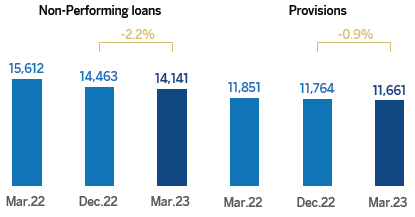
| – | The NPL ratio stood at 3.3% as of March 31, 2023, 11 basis points below the figure recorded in December 2022 and 65 basis points below that of March 2022. Noteworthy is the change in Turkey, which improved by 77 basis points compared to the end of 2022 and 239 basis points compared to the first quarter of last year. |
| – | Loan-loss provisions remained almost stable compared to the figure at the end of the fourth quarter (-0.9% with respect to December 2022). |
| – | The NPL coverage ratio stood at 82%, 112 basis points higher than the figure at the end of 2022 (655 basis points higher than the first quarter of 2022), mainly due to the evolution in Turkey and Mexico. |
| – | The cumulative cost of risk as of March 31, 2023 stood at 1.05%. Lower requirements compared to the previous quarter in all geographical areas except Mexico, Argentina and Rest of Business. |
NPL AND NPL COVERAGE RATIOS AND COST OF RISK (PERCENTAGE)
|
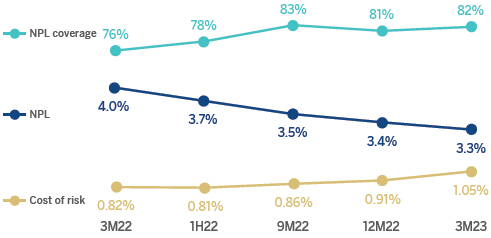
CREDIT RISK (1) (MILLIONS OF EUROS)
|
| 31-03-23 | 31-12-22 | 30-09-22 | 30-06-22 | 31-03-22 | ||||||||||||||||
Credit risk | 428,423 | 423,669 | 428,064 | 413,638 | 394,861 | |||||||||||||||
Non-performing loans | 14,141 | 14,463 | 15,162 | 15,501 | 15,612 | |||||||||||||||
Provisions | 11,661 | 11,764 | 12,570 | 12,159 | 11,851 | |||||||||||||||
NPL ratio (%) | 3.3 | 3.4 | 3.5 | 3.7 | 4.0 | |||||||||||||||
NPL coverage ratio (%) (2) | 82 | 81 | 83 | 78 | 76 | |||||||||||||||
(1) Includes gross loans and advances to customers plus contingent liabilities.
(2) The NPL coverage ratio includes the valuation adjustments for credit risk throughout the expected residual life in those financial instruments that have been acquired (mainly originating from the acquisition of Catalunya Banc, S.A.). If these valuation corrections had not been taken into account, the NPL coverage ratio would have stood at 81% as of March 31, 2023, 80% as of December 31, 2022 and 74% as of March 31, 2022.
| 22 |
NON-PERFORMING LOANS EVOLUTION (MILLIONS OF EUROS)
|
| 1Q23 (1) | 4Q22 | 3Q22 | 2Q22 | 1Q22 | ||||||||||||||||||||||||||||||||
Beginning balance | 14,463 | 15,162 | 15,501 | 15,612 | 15,443 | |||||||||||||||||||||||||||||||
Entries | 2,259 | 2,332 | 1,871 | 2,085 | 1,762 | |||||||||||||||||||||||||||||||
Recoveries | (1,526) | (1,180) | (1,595) | (1,697) | (1,280) | |||||||||||||||||||||||||||||||
Net variation | 733 | 1,152 | 276 | 388 | 482 | |||||||||||||||||||||||||||||||
Write-offs | (1,102) | (928) | (683) | (579) | (581) | |||||||||||||||||||||||||||||||
Exchange rate differences and other | 48 | (923) | 67 | 80 | 269 | |||||||||||||||||||||||||||||||
Period-end balance | 14,141 | 14,463 | 15,162 | 15,501 | 15,612 | |||||||||||||||||||||||||||||||
Memorandum item: | ||||||||||||||||||||||||||||||||||||
Non-performing loans | 13,215 | 13,493 | 14,256 | 14,597 | 14,731 | |||||||||||||||||||||||||||||||
Non performing guarantees given | 926 | 970 | 906 | 904 | 881 | |||||||||||||||||||||||||||||||
(1) Preliminary data.
Structural risks
Liquidity and funding
Liquidity and funding management at BBVA aims to finance the recurring growth of the banking business at suitable maturities and costs, using a wide range of instruments that provide access to a large number of alternative sources of financing. BBVA’s business model, risk appetite framework and funding strategy determine a solid funding structure based on stable customer deposits, mainly retail (granular). As a result of this model, deposits have a high degree of insurance in each geographical area, close to 60% in Spain and Mexico. In this regard, it is important to note that, given the nature of BBVA’s business, lending is mainly financed through stable customer funds.
One of the key elements in the BBVA Group’s liquidity and funding management is the maintenance of large high-quality liquidity buffers in all geographical areas. In this respect, the Group has maintained during the last 12 months an average volume of high quality liquid assets (HQLA) of €141.3 billion, of which 96% corresponds to maximum quality assets (level 1 in the LCR).
Due to its subsidiary-based management model, BBVA is one of the few major European banks that follows the Multiple Point of Entry (MPE) resolution strategy: the parent company sets the liquidity policies, but the subsidiaries are self-sufficient and responsible for managing their own liquidity and funding (taking deposits or accessing the market with their own rating), without fund transfers or financing occurring between either the parent company and the subsidiaries or between the different subsidiaries. This strategy limits the spread of a liquidity crisis among the Group’s different areas and ensures that the cost of liquidity and financing is correctly reflected in the price formation process.
The BBVA Group maintains a solid liquidity position in every geographical area in which it operates, with ratios well above the minimum required:
| – | The liquidity coverage ratio (LCR) requires banks to maintain a volume of high-quality liquid assets sufficient to withstand liquidity stress for 30 days. BBVA Group’s consolidated LCR remained comfortably above 100% during 2022 and stood at 142% as of March 31, 2023. It should be noted that, given the MPE nature of BBVA, this ratio limits the numerator of the LCR for subsidiaries other than BBVA S.A. to 100%. Therefore, the resulting ratio is below that of the individual units (the main components, the LCR of BBVA S.A. is 161%, Mexico 188% and Turkey 217%). If this restriction was eliminated, the Group’s LCR ratio would reach 184%. |
| – | The net stable funding ratio (NSFR) requires banks to maintain a stable funding profile in relation to the composition of their assets and off-balance sheet activities. The BBVA Group’s NSFR ratio, stood at 132% as of March 31, 2023. |
The breakdown of these ratios in the main geographical areas in which the Group operates is shown below:
LCR AND NSFR RATIOS (PERCENTAGE. 31-03-23)
| ||||||||
| BBVA, S.A. | Mexico | Turkey | South America | |||||
LCR | 161% | 188% | 217% | All countries >100 | ||||
NSFR | 123% | 138% | 173% | All countries >100 | ||||
It should be noted that episodes of volatility in the financial markets during the first quarter of 2023, related to events in American regional banks and a Swiss bank, have had no significant impact on the liquidity and financing situation of the BBVA Group units. In addition to the above, the most relevant aspects related to the main geographical areas are the following:
| – | BBVA, S.A. has maintained a comfortable position with a large high-quality liquidity buffer. During the first quarter of 2023, commercial activity has been characterized by the decline in lending volumes and customer deposits, these latter influenced by the seasonal component and by the transfer to off-balance sheet funds. In addition, in December 2022 the Bank started the repayment of the TLTRO III program for an amount of €12 billion, plus an additional repayment of €12 billion between February and March 2023, which together represent approximately two thirds of the original amount. BBVA’s solid liquidity situation has allowed the Bank to bring forward a part of the maturities while maintaining regulatory liquidity metrics well above the established minimums. |
| 23 |
| – | BBVA Mexico, continues to present a comfortable liquidity situation, which has contributed to an efficient management of the cost of funds, in an environment of rising interest rates. During the first quarter of the year, however, commercial activity has drained liquidity mainly due to the seasonal outflow of funds, coupled with sustained loan growth. |
| – | In Turkey, in the first quarter of 2023, the lending gap in local currency has been reduced, due to a greater growth in deposits than in loans. The lending gap in foreign currency has increased due to reductions in deposits as a result of the mechanism established to encourage Turkish lira deposits, and an increase in in foreign currency loans. Garanti BBVA continues to maintain a stable liquidity position with comfortable ratios. For its part, the Central Bank of Turkey has continued to implement measures in order to reduce the dollarization of the economy. |
| – | In South America, the liquidity situation remains adequate throughout the region. In Argentina, liquidity continues to increase in the system and in BBVA due to a higher growth in deposits than in loans in local currency. In BBVA Colombia, the liquidity situation also improves in the quarter, with deposits growing more than loans. BBVA Peru maintains solid liquidity levels, thanks to the higher growth in deposits than in lending, affected by the expiration of loans covered by COVID-19 programs. The political instability is not having material impacts in terms of liquidity. |
The main wholesale financing transactions carried out by the entities of the BBVA Group are listed below.
In January 2023, BBVA, S.A. carried out two public bond issuance operations: a senior non-preferred bond for €1,000m with a term of 8 years and an early redemption option in the 7th year at 4.625% and a €1,500m mortgage bond with a term of 4 and a half years at 3.125%.
For its part, on February 15, BBVA Mexico carried out two operations, the first of which involved the issue of a green bond for 8,689 million Mexican pesos (approximately €442m) with a maturity of 4 years, the second issue of this type by BBVA Mexico, using the TIIE (Balanced Interbank Interest Rate used in Mexico) rate as benchmark, at one day +32 basis points; and the second was the issue of a senior bond for 6,131 million Mexican pesos (approximately €312m) at a fixed rate of 9.54% and a term of 7 years.
Foreign exchange
Foreign exchange risk management aims to reduce both the sensitivity of the capital ratios and the net attributable profit variability to currency fluctuations.
The factors affecting the Group’s main currencies during the first quarter of 2023 have been very disparate, hence the diversity of performance. On the positive side, due to its relevance for the Group, it is worth highlighting the continued strength of the Mexican peso, which has appreciated 6.2% against the euro. Other Latin American currencies that also performed well in the first three months of the year were the Chilean peso (+6.8%) and the Colombian peso (+2.0%). On the other hand, the Argentine peso’s depreciation (-16.9%) was higher than it had been in the past, while that of the Peruvian sol was irrelevant (-0.8%). As for the Turkish lira, the 4.3% depreciation can be described as moderate. For its part, the U.S. dollar fell 1.9% against the euro, although it moved in a narrower range than in previous quarters.
EXCHANGE RATES (EXPRESSED IN CURRENCY/EURO)
| ||||||||||||||||
| Period-end exchange rates | Average exchange rates | |||||||||||||||||||
| Δ % on | Δ % on | Δ % on | ||||||||||||||||||
| 31-03-23 | 31-03-22 | 31-12-22 | 1Q23 | 1Q22 | ||||||||||||||||
U.S. dollar | 1.0875 | 2.1 | (1.9) | 1.0730 | 4.5 | |||||||||||||||
Mexican peso | 19.6392 | 12.5 | 6.2 | 20.0431 | 14.7 | |||||||||||||||
Turkish lira (1) | 20.8632 | (22.0) | (4.3) | — | — | |||||||||||||||
Peruvian sol | 4.0902 | 0.7 | (0.8) | 4.0902 | 4.3 | |||||||||||||||
Argentine peso (1) | 226.85 | (45.7) | (16.9) | — | — | |||||||||||||||
Chilean peso | 858.39 | 1.8 | 6.8 | 871.43 | 4.2 | |||||||||||||||
Colombian peso | 5,032.16 | (17.3) | 2.0 | 5,107.57 | (14.1) | |||||||||||||||
(1) According to IAS 21 “The effects of changes in foreign exchange rates”, the year-end exchange rate is used for the conversion of the Turkey and Argentina income statement.
In relation to the hedging of the capital ratios, BBVA covers, in aggregate, 70% of its subsidiaries’ capital excess. The sensitivity of the Group’s CET1 fully-loaded ratio to 10% depreciations in major currencies is estimated at: +17 basis points for the U.S. dollar, -11 basis points for the Mexican peso and -1 basis point for the Turkish lira. With regard to the hedging of results, BBVA hedges between 40% and 50% of the aggregate net attributable profit it expects to generate in the next 12 months. For each currency, the final amount hedged depends on its expected future evolution, the costs and the relevance of the incomes related to the Group’s results as a whole.
Interest rate
Interest rate risk management seeks to limit the impact that BBVA may suffer, both in terms of net interest income (short-term) and economic value (long-term), from adverse movements in the interest rate curves in the various currencies in which the Group operates. BBVA carries out this work through an internal procedure, pursuant to the guidelines established by the European Banking Authority (EBA), in order to analyze the potential impact that could derive from a range of scenarios on the Group’s different balance sheets.
| 24 |
The model is based on assumptions intended to realistically mimic the behavior of the balance sheet. Of particular relevance are assumptions regarding the behavior of accounts with no explicit maturity and prepayment estimates. These assumptions are reviewed and adapted at least once a year to take into account any changes in observed behavior.
At the aggregate level, BBVA continues to have a positive sensitivity toward interest rate increases in the net interest income.
The first quarter of 2023 was characterized by persistent inflation in most of the countries where the Group operates. While it is true that some improvement in headline inflation is observable, core inflation is still resilient and, therefore, offers central banks a solid argument to continue with their strategy of raising interest rates. It is important to note that financial markets experienced a strong bout of volatility in March, stemming from the crisis arisen in certain American regional banks and another bank of Swiss origin. These events triggered sharp falls in sovereign debt curves and markets came to question whether central banks should pause their rate hike strategy. As a result, while the short tranches of sovereign curves remained under pressure, longer-term benchmarks fell in the quarter, with significant declines in 10-year benchmarks in both Germany and the United States. Meanwhile, the risk premium in Spain and especially Italy experienced an improvement with respect to the German curve. In Mexico, the central bank also continues to raise rates, a situation that is repeated in several South American countries, such as Colombia, Peru and Argentina. Turkey, for its part, continues with the opposite strategy of lowering rates.
By area, the main features are:
| – | Spain has a balance sheet characterized by a high proportion of variable-rate loans (mortgages and corporate lending) and liabilities composed mainly by customer demand deposits. The ALCO portfolio acts as a management lever and hedging for the balance sheet, mitigating its sensitivity to interest rate fluctuations. The balance sheet interest rate risk profile remained stable during the year, with Spain as the franchise with the highest positive sensitivity to rates in the Group. |
On the other hand, in March 2023 the ECB set the benchmark interest rate at 3.50%, held the marginal deposit facility rate at 3.00% and the marginal loan facility rate at 3.75%. Thus, Euribor reference rates continued to rise in the quarter. In this regard, customer spread is benefiting from the interest rate hikes and the containment in the cost of deposits. |
| – | Mexico continues to show a balanced situation between fixed and variable interest rates balances, which results in a limited sensitivity to interest rates fluctuations. In terms of assets that are most sensitive to interest rate fluctuations, the commercial portfolio stands out, while consumer loans and mortgages are mostly at a fixed rate. With regard to the customer funds, the high proportion of non-interest bearing deposits should be highlighted, which are insensitive to interest rate movements. The ALCO portfolio is invested primarily in fixed-rate sovereign bonds with limited maturities. The monetary policy rate stands at 11.25%, 75 basis points above the end-of-year level of 2022. Regarding customer spread, there has been improvement so far in the first quarter of 2023, favored by both the contained cost of deposits and the positive evolution of loan yield. |
| – | In Turkey, the sensitivity of loans, which are mostly fixed-rate but with relatively short maturities, and the ALCO portfolio balance the sensitivity of deposits on the liability side. Thus, the sensitivity of net interest income remains limited, both in Turkish lira and in foreign currencies. The customer spread worsened in the first quarter of 2023 due to the higher cost of deposits and the limits on lending rates. |
| – | In South America, the interest rate risk profile remains low as most countries in the area have a fixed/variable composition and maturities that are very similar for assets and liabilities, with limited net interest income sensitivity. In addition, in balance sheets with several currencies, interest rate risk is managed for each of the currencies, showing a very low level of risk. Regarding the benchmark rates of the central banks of Peru and Colombia, they have raised interest rates by 25 and 100 basis points, respectively, during the first quarter of 2023. The customer spread worsens in Colombia, impacted by an increase in the cost of deposits which does not apply in the same way to loan yields, and remains almost flat in Peru. |
INTEREST RATES (PERCENTAGE) | ||||||||||||||||||||
| 31-03-23 | 31-12-22 | 30-09-22 | 30-06-22 | 31-03-22 | ||||||||||||||||
| Official ECB rate | 3.50 | 2.50 | 1.25 | 0.00 | 0.00 | |||||||||||||||
| Euribor 3 months (1) | 2.91 | 2.06 | 1.01 | (0.24) | (0.50) | |||||||||||||||
| Euribor 1 year (1) | 3.65 | 3.02 | 2.23 | 0.85 | (0.24) | |||||||||||||||
| USA Federal rates | 5.00 | 4.50 | 3.25 | 1.75 | 0.50 | |||||||||||||||
| TIIE (Mexico) | 11.25 | 10.50 | 9.25 | 7.75 | 6.50 | |||||||||||||||
| CBRT (Turkey) | 8.50 | 9.00 | 12.00 | 14.00 | 14.00 | |||||||||||||||
(1) Calculated as the month average.
| 25 |
This section presents the most relevant aspects of the Group’s different business areas. Specifically, for each one of them, it shows a summary of the income statements and balance sheets, the business activity figures and the most significant ratios.
The structure of the business areas reported by the BBVA Group as of March 31, 2023, is identical with the one presented at the end of 2022.
The composition of BBVA Group’s business areas is summarized below:
| – | Spain mainly includes the banking, insurance and asset management activities that the Group carries out in this country. |
| – | Mexico includes banking, insurance and asset management activities in this country, as well as the activity that BBVA Mexico carries out through its agency in Houston. |
| – | Turkey reports the activity of the group Garanti BBVA that is mainly carried out in this country and, to a lesser extent, in Romania and the Netherlands. |
| – | South America includes banking, financial, insurance and asset management activities conducted, mainly, in Argentina, Chile, Colombia, Peru, Uruguay and Venezuela. |
| – | Rest of Business mainly incorporates the wholesale activity carried out in Europe (excluding Spain), the United States, and BBVA’s branches in Asia. |
The Corporate Center contains the centralized functions of the Group, including: the costs of the head offices with a corporate function; structural exchange rate positions management; portfolios whose management is not linked to customer relations, such as financial and industrial holdings; stakes in Funds & Investment Vehicles in tech companies; certain tax assets and liabilities; funds due to commitments to employees; goodwill and other intangible assets as well as such portfolios and assets’ funding.
In addition to these geographical breakdowns, supplementary information is provided for the wholesale business carried out by BBVA, Corporate & Investment Banking (CIB), in the countries where it operates. This business is relevant to have a broader understanding of the Group’s activity and results due to the important features of the type of customers served, products offered and risks assumed.
The information by business areas is based on units at the lowest level and/or companies that make up the Group, which are assigned to the different areas according to the main region or company group in which they carry out their activity.
Regarding the shareholders’ funds allocation, in the business areas, a capital allocation system based on the consumed regulatory capital is used.
Finally, it should be noted that, as usual, in the case of the different business areas, that is, Mexico, Turkey, South America and Rest of Business, and, additionally, CIB, in addition to the year-on-year variations applying current exchange rates, the variations at constant exchange rates are also disclosed.
| GROSS INCOME (1), OPERATING INCOME (1) AND NET ATTRIBUTABLE PROFIT (1) BREAKDOWN (PERCENTAGE. 1Q23) |

(1) Excludes the Corporate Center.
| 26 |
MAIN INCOME STATEMENT LINE ITEMS BY BUSINESS AREA (MILLIONS OF EUROS) |
| |||||||||||||||||||||||||||||||
| Business areas | ||||||||||||||||||||||||||||||||
| BBVA Group | Spain | Mexico | Turkey | South America | Rest of Business | Σ Business areas | Corporate Center | |||||||||||||||||||||||||
1Q23 | ||||||||||||||||||||||||||||||||
| Net interest income | 5,642 | 1,183 | 2,589 | 626 | 1,190 | 113 | 5,702 | (60) | ||||||||||||||||||||||||
Gross income | 6,958 | 1,726 | 3,306 | 802 | 1,175 | 260 | 7,269 | (311) | ||||||||||||||||||||||||
Operating income | 3,942 | 974 | 2,318 | 403 | 642 | 122 | 4,458 | (516) | ||||||||||||||||||||||||
| Profit (loss) before tax | 2,944 | 851 | 1,768 | 327 | 405 | 111 | 3,463 | (519) | ||||||||||||||||||||||||
Net attributable profit (loss) | 1,846 | 541 | 1,285 | 277 | 184 | 92 | 2,378 | (531) | ||||||||||||||||||||||||
1Q22 (1) | ||||||||||||||||||||||||||||||||
| Net interest income | 3,943 | 856 | 1,748 | 492 | 809 | 75 | 3,980 | (37) | ||||||||||||||||||||||||
Gross income | 5,395 | 1,655 | 2,232 | 500 | 885 | 202 | 5,474 | (79) | ||||||||||||||||||||||||
Operating income | 2,989 | 946 | 1,487 | 262 | 473 | 87 | 3,255 | (266) | ||||||||||||||||||||||||
| Profit (loss) before tax | 2,225 | 837 | 1,067 | 155 | 315 | 105 | 2,480 | (255) | ||||||||||||||||||||||||
Net attributable profit (loss) | 1,325 | 598 | 777 | (76) | 160 | 81 | 1,540 | (215) | ||||||||||||||||||||||||
(1) Restated balances according to IFRS17 - Insurance contracts.
MAIN BALANCE-SHEET ITEMS AND RISK-WEIGHTED ASSETS BY BUSINESS AREA (MILLIONS OF EUROS) |
| |||||||||||||||||||||||||||||||||||
| Business areas | ||||||||||||||||||||||||||||||||||||
| BBVA Group | Spain | Mexico | Turkey | South America | Rest of Business | Σ Business areas | Corporate Center | Deletions | ||||||||||||||||||||||||||||
31-03-23 | ||||||||||||||||||||||||||||||||||||
| Loans and advances to customers | 362,317 | 172,085 | 77,277 | 38,995 | 39,185 | 35,946 | 363,488 | 402 | (1,573) | |||||||||||||||||||||||||||
Deposits from customers | 395,880 | 214,476 | 80,172 | 51,234 | 40,782 | 10,070 | 396,733 | 186 | (1,039) | |||||||||||||||||||||||||||
Off-balance sheet funds | 160,959 | 90,577 | 44,408 | 7,491 | 17,971 | 510 | 160,958 | 0 | — | |||||||||||||||||||||||||||
| Total assets/liabilities and equity | 739,564 | 441,720 | 151,955 | 71,222 | 63,063 | 50,407 | 778,367 | 22,396 | (61,198) | |||||||||||||||||||||||||||
RWAs | 348,598 | 116,550 | 78,316 | 58,683 | 47,341 | 33,725 | 334,615 | 13,983 | — | |||||||||||||||||||||||||||
31-12-22 (1) | ||||||||||||||||||||||||||||||||||||
| Loans and advances to customers | 357,351 | 173,971 | 71,231 | 37,443 | 38,437 | 37,375 | 358,456 | 278 | (1,383) | |||||||||||||||||||||||||||
Deposits from customers | 394,404 | 221,019 | 77,750 | 46,339 | 40,042 | 9,827 | 394,978 | 187 | (760) | |||||||||||||||||||||||||||
Off-balance sheet funds | 150,172 | 86,759 | 38,196 | 6,936 | 17,760 | 520 | 150,170 | 2 | — | |||||||||||||||||||||||||||
| Total assets/liabilities and equity | 712,092 | 427,116 | 142,557 | 66,036 | 61,951 | 49,952 | 747,613 | 22,719 | (58,239) | |||||||||||||||||||||||||||
RWAs | 337,066 | 114,474 | 71,738 | 56,275 | 46,834 | 35,064 | 324,385 | 12,682 | — | |||||||||||||||||||||||||||
(1) Restated balances according to IFRS17 - Insurance contracts.
| 27 |
NUMBER OF EMPLOYEES | NUMBER OF BRANCHES | |||
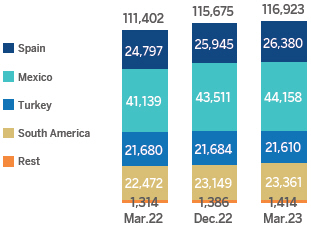 | 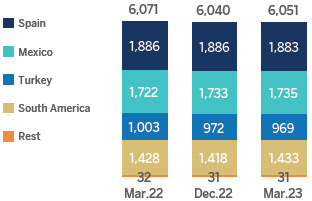 | |||
| ||||
NUMBER OF ATMS | ||||
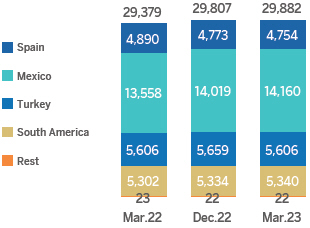 | ||||
| 28 |
Highlights
| • | Seasonal drop in lending |
| • | Significant improvement in net interest income |
| • | Recording of the temporary tax on credit institutions for the financial year 2023 |
| • | Cost of risk remains at low levels, in line with the end of 2022 |
BUSINESS ACTIVITY (1) (VARIATION COMPARED TO 31-12-22) |
NET INTEREST INCOME / AVERAGE TOTAL ASSETS (PERCENTAGE) | |||
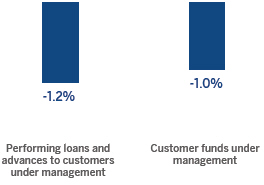 | 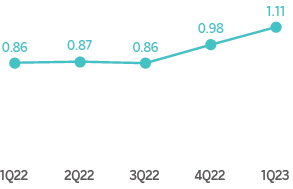 | |||
(1) Excluding repos.
OPERATING INCOME (MILLIONS OF EUROS)
| NET ATTRIBUTABLE PROFIT (LOSS) (MILLIONS OF EUROS) | |||
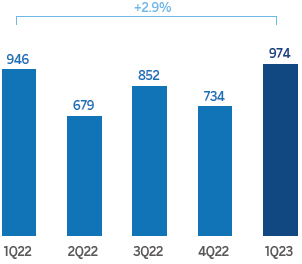 | 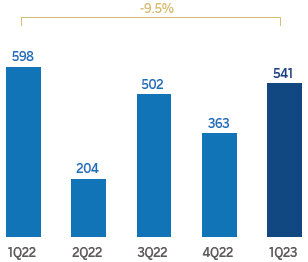 | |||
| 29 |
FINANCIAL STATEMENTS AND RELEVANT BUSINESS INDICATORS (MILLIONS OF EUROS AND PERCENTAGE) |
| |||||||||||
| Income statement | 1Q23 | Δ % | 1Q22 (1) | |||||||||
Net interest income | 1,183 | 38.2 | 856 | |||||||||
Net fees and commissions | 536 | — | 536 | |||||||||
Net trading income | 120 | (36.9) | 190 | |||||||||
Other operating income and expenses | (112) | n.s. | 73 | |||||||||
Of which: Insurance activities | 99 | 10.2 | 90 | |||||||||
Gross income | 1,726 | 4.3 | 1,655 | |||||||||
Operating expenses | (753) | 6.2 | (709) | |||||||||
Personnel expenses | (414) | 8.2 | (383) | |||||||||
Other administrative expenses | (245) | 10.3 | (222) | |||||||||
Depreciation | (94) | (9.8) | (105) | |||||||||
Operating income | 974 | 2.9 | 946 | |||||||||
Impairment on financial assets not measured at fair value through profit or loss | (114) | 27.0 | (89) | |||||||||
Provisions or reversal of provisions and other results | (9) | (55.0) | (19) | |||||||||
Profit (loss) before tax | 851 | 1.7 | 837 | |||||||||
Income tax | (310) | 30.1 | (238) | |||||||||
Profit (loss) for the period | 541 | (9.6) | 599 | |||||||||
Non-controlling interests | (1) | (33.3) | (1) | |||||||||
Net attributable profit (loss) | 541 | (9.5) | 598 | |||||||||
| Balance sheets | 31-03-23 | Δ % | 31-12-22 (1) | |||||||||
Cash, cash balances at central banks and other demand deposits | 50,952 | 3.6 | 49,185 | |||||||||
Financial assets designated at fair value | 137,432 | 8.7 | 126,413 | |||||||||
Of which: Loans and advances | 47,764 | 13.9 | 41,926 | |||||||||
Financial assets at amortized cost | 207,349 | 1.4 | 204,528 | |||||||||
Of which: Loans and advances to customers | 172,085 | (1.1) | 173,971 | |||||||||
Inter-area positions | 37,955 | (2.5) | 38,924 | |||||||||
Tangible assets | 2,957 | (1.1) | 2,990 | |||||||||
Other assets | 5,075 | (0.0) | 5,076 | |||||||||
Total assets/liabilities and equity | 441,720 | 3.4 | 427,116 | |||||||||
| Financial liabilities held for trading and designated at fair value through profit or loss | 96,927 | 14.5 | 84,619 | |||||||||
| Deposits from central banks and credit institutions | 60,305 | 16.6 | 51,702 | |||||||||
| Deposits from customers | 214,476 | (3.0) | 221,019 | |||||||||
| Debt certificates | 40,898 | 0.3 | 40,782 | |||||||||
| Inter-area positions | — | — | — | |||||||||
Other liabilities | 14,777 | (6.9) | 15,870 | |||||||||
Regulatory capital allocated | 14,337 | 9.2 | 13,124 | |||||||||
| Relevant business indicators | 31-03-23 | Δ % | 31-12-22 | |||||||||
Performing loans and advances to customers under management (2) | 169,215 | (1.2) | 171,209 | |||||||||
Non-performing loans | 7,668 | (2.8) | 7,891 | |||||||||
Customer deposits under management (2) | 213,311 | (3.1) | 220,140 | |||||||||
Off-balance sheet funds (3) | 90,577 | 4.4 | 86,759 | |||||||||
Risk-weighted assets | 116,550 | 1.8 | 114,474 | |||||||||
Efficiency ratio (%) | 43.6 | 47.5 | ||||||||||
NPL ratio (%) | 3.9 | 3.9 | ||||||||||
NPL coverage ratio (%) | 59 | 61 | ||||||||||
Cost of risk (%) | 0.27 | 0.28 | ||||||||||
(1) Restated balances according to IFRS17 - Insurance contracts.
(2) Excluding repos.
(3) Includes mutual funds, customer portfolios and pension funds.
| 30 |
Macro and industry trends
After growing by 5.5% in 2022, GDP will increase by around 1.6% in 2023 according to BBVA Research, a forecast two tenths of a percentage point higher than the previous forecast, mainly due to the significant reduction in energy prices and the dynamism of economic activity in recent months. Growth is also expected to moderate further ahead, in line with the outlook of tighter monetary conditions and a slowdown in global and European growth. Annual inflation, which closed 2022 at 5.7%, moderated to 3.3% in March, helped by lower energy prices and favorable base effects. It is expected to average around 3.9% in 2023, above the ECB’s 2% target.
As for the banking sector, based on data as of January 2023, the volume of credit to the private sector remained stable, with a slight decline of 0.6% year-on-year. At the end of December 2022 (latest data available by credit portfolios), lending to households remains stable while lending to companies fell by 1.1% in the year. Customer deposits grew by 0.6% year-on-year with data as of the end of January 2023, thanks to the growth in demand deposits, as time deposits continued their downward trend, albeit at a slower pace (-4.5% year-on-year). The NPL ratio continued to fall to 3.56% in January 2023, 77 basis points lower than in January 2022. It should also be noted that the system maintains comfortable solvency and liquidity levels.
Activity
The most relevant aspects related to the area’s activity during the first quarter of 2023 were:
| – | Lending activity decreased (-1.2%), as a result of mortgage payoffs by some customers, which were not offset by the growth in the loans to SMEs (+0.7%) and the public sector (+3.5%). |
| – | In terms of credit quality, the NPL ratio showed a minor decrease of 5 basis points compared to the end of December 2022 and stood at 3.9%, mainly due to the volume of write-offs made during the quarter. The coverage ratio also decreased during the quarter, to 59%, due to the aforementioned shift to write-offs. |
| – | Total customer funds recorded a reduction of 1.0%, which is explained by the lower balances of customer deposits under management, which in December 2022 included extraordinary payments, and customer contributions to off-balance sheet funds. Thus, the variation in demand deposits was -3.8% and +3.3% in the case of time deposits, with the latter having a limited weight in total customer deposits (10.7% at the end of March 2023). Off-balance sheet funds (mutual and pension funds) increased by 4.4%, favored by net contributions in the quarter, despite the turbulence in the markets towards the end of the quarter. |
Results
Spain generated a net attributable profit of €541m in the first quarter of the year 2023, 9.5% lower than in the same period of the previous year, due to the recording, on January 1, 2023, of the temporary tax on credit institutions and financial credit institutions for €225m, included in the other operating income and expenses line of the income statement. In addition, the dynamism of the net interest income stands out.
The most notable aspects of the year-on-year changes in the area’s income statement at the end of March 2023 were:
| – | Net interest income, with a significant year-on-year growth of 38.2%, continued to benefit from the improvement in customer spreads, in a context of interest rate hikes. |
| – | Net fees and commissions were in line with the previous year, as a result of a lower contribution from asset management and banking services fees, offset by higher income from wholesale operations. |
| – | Decrease in the year-on-year NTI contribution (-36.9%), with a lower contribution from the ALCO portfolios, partially offset by the good performance of Global Markets. |
| – | Other operating income and expenses compared negatively with the previous year, due to the €225m recorded in this line for the temporary tax on credit institutions and financial credit institutions for the year 2023. For its part, the performance of the insurance business was higher than in the previous year (+10.2%). |
| – | Growth in operating expenses (+6.2%), both in personnel expenses due to higher fixed remuneration, with additional measures that improve those of the sectoral wage increase agreement, and in general expenses, as a result of inflation, especially higher IT expenses. |
| – | For its part, the gross income increased by 4.3%, below the growth in expenses. This increase is affected by the recording of the temporary tax on credit institutions and financial credit establishments. Thus, the efficiency ratio stood at 43.6%. |
| – | Impairment on financial assets was 27.0% higher than in the first quarter of 2022, due to higher provisions needs in the loan portfolio, as well as the recording of some non-recurring positive items in the first quarter of 2022. As a result of the above, the cumulative cost of risk at the end of March 2023 stood at 0.27%, below the 0.28% registered at the end of December 2022. |
| – | Provisions and other results closed the first quarter of 2023 at €-9m, which compares favorably with the previous year, thanks, among other factors, to lower provisions for legal contingencies and higher release of provisions for risks and contingent commitments. |
| 31 |
Highlights
| • | Favorable performance of the portfolio, with greater dynamism of the retail segment |
| • | Increase in net interest income as a result of effective spread management |
| • | Outstanding evolution of the efficiency ratio |
| • | Significant growth in net attributable profit |
BUSINESS ACTIVITY (1) (VARIATION AT CONSTANT EXCHANGE RATE COMPARED TO 31-12-22) |
| NET INTEREST INCOME / AVERAGE TOTAL ASSETS (PERCENTAGE AT CONSTANT EXCHANGE RATE) | ||
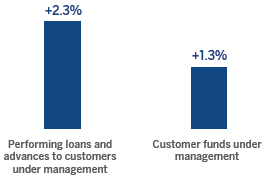 | 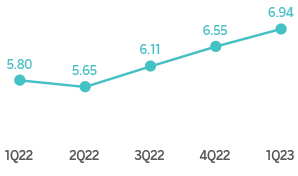 |
(1) Excluding repos.
OPERATING INCOME (MILLIONS OF EUROS AT CONSTANT EXCHANGE RATE) |
| NET ATTRIBUTABLE PROFIT (LOSS) (MILLIONS OF EUROS AT CONSTANT EXCHANGE RATE) | ||
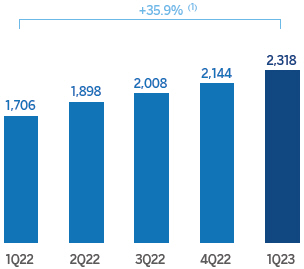 | 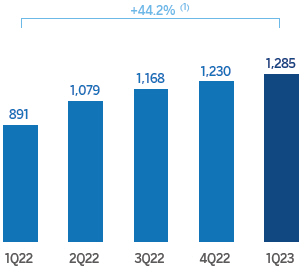 | |||
(1) At current exchange rate: +55.9%. | (1) At current exchange rate: +65.4%. | |||
| 32 |
FINANCIAL STATEMENTS AND RELEVANT BUSINESS INDICATORS (MILLIONS OF EUROS AND PERCENTAGE) |
| |||||||||||||||
| Income statement | 1Q23 | Δ % | Δ % (1) | 1Q22 (2) | ||||||||||||
Net interest income | 2,589 | 48.2 | 29.2 | 1,748 | ||||||||||||
Net fees and commissions | 483 | 40.4 | 22.4 | 344 | ||||||||||||
Net trading income | 149 | 61.9 | 41.1 | 92 | ||||||||||||
Other operating income and expenses | 86 | 77.2 | 54.5 | 48 | ||||||||||||
Gross income | 3,306 | 48.2 | 29.2 | 2,232 | ||||||||||||
Operating expenses | (988) | 32.8 | 15.7 | (744) | ||||||||||||
Personnel expenses | (455) | 37.3 | 19.7 | (332) | ||||||||||||
Other administrative expenses | (424) | 31.6 | 14.8 | (322) | ||||||||||||
Depreciation | (109) | 20.0 | 4.6 | (90) | ||||||||||||
Operating income | 2,318 | 55.9 | 35.9 | 1,487 | ||||||||||||
Impairment on financial assets not measured at fair value through profit or loss | (549) | 31.2 | 14.4 | (419) | ||||||||||||
Provisions or reversal of provisions and other results | (1) | (38.7) | (46.5) | (1) | ||||||||||||
Profit (loss) before tax | 1,768 | 65.6 | 44.4 | 1,067 | ||||||||||||
Income tax | (483) | 66.2 | 44.9 | (291) | ||||||||||||
Profit (loss) for the period | 1,285 | 65.4 | 44.2 | 777 | ||||||||||||
Non-controlling interests | (0) | 69.6 | 47.8 | (0) | ||||||||||||
Net attributable profit (loss) | 1,285 | 65.4 | 44.2 | 777 | ||||||||||||
| Balance sheets | 31-03-23 | Δ % | Δ% (1) | 31-12-22 (2) | ||||||||||||
Cash, cash balances at central banks and other demand deposits | 12,726 | (3.8) | (9.4) | 13,228 | ||||||||||||
Financial assets designated at fair value | 48,366 | 3.8 | (2.2) | 46,575 | ||||||||||||
Of which: Loans and advances | 1,386 | (8.0) | (13.4) | 1,507 | ||||||||||||
Financial assets at amortized cost | 84,617 | 9.6 | 3.2 | 77,191 | ||||||||||||
Of which: Loans and advances to customers | 77,277 | 8.5 | 2.2 | 71,231 | ||||||||||||
Tangible assets | 2,098 | 6.5 | 0.3 | 1,969 | ||||||||||||
Other assets | 4,148 | 15.4 | 8.7 | 3,593 | ||||||||||||
Total assets/liabilities and equity | 151,955 | 6.6 | 0.4 | 142,557 | ||||||||||||
Financial liabilities held for trading and designated at fair value through profit or loss | 28,035 | 8.5 | 2.2 | 25,840 | ||||||||||||
Deposits from central banks and credit institutions | 6,862 | 55.9 | 46.8 | 4,402 | ||||||||||||
Deposits from customers | 80,172 | 3.1 | (2.9) | 77,750 | ||||||||||||
Debt certificates | 8,317 | 7.2 | 1.0 | 7,758 | ||||||||||||
Other liabilities | 19,224 | 13.2 | 6.6 | 16,976 | ||||||||||||
Regulatory capital allocated | 9,344 | (4.9) | (10.5) | 9,831 | ||||||||||||
| Relevant business indicators | 31-03-23 | Δ % | Δ % (1) | 31-12-22 | ||||||||||||
Performing loans and advances to customers under management (3) | 77,997 | 8.6 | 2.3 | 71,788 | ||||||||||||
Non-performing loans | 1,951 | 0.6 | (5.3) | 1,939 | ||||||||||||
Customer deposits under management (3) | 79,665 | 3.3 | (2.7) | 77,117 | ||||||||||||
Off-balance sheet funds (4) | 44,408 | 16.3 | 9.5 | 38,196 | ||||||||||||
Risk-weighted assets | 78,316 | 9.2 | 2.8 | 71,738 | ||||||||||||
Efficiency ratio (%) | 29.9 | 31.7 | ||||||||||||||
NPL ratio (%) | 2.3 | 2.5 | ||||||||||||||
NPL coverage ratio (%) | 137 | 129 | ||||||||||||||
Cost of risk (%) | 2.88 | 2.49 | ||||||||||||||
(1) At constant exchange rate.
(2) Restated balances according to IFRS17 - Insurance contracts.
(3) Excluding repos.
(4) Includes mutual funds, customer portfolios and other off-balance sheet funds.
| 33 |
Macro and industry trends
Economic activity is likely to lose some of the dynamism it showed in 2022, when GDP grew by 3.1%, slightly above BBVA Research’s forecast. However, the moderation this year will be less accentuated than previously expected: GDP will grow by 1.4%, eight tenths of a percentage point more than the forecast of three months ago, supported mainly by private consumption. Inflation, which closed 2022 at 7.8%, reached 6.9% in March and could average around 5.7% in 2023, well above the inflation target. Price pressures, as well as the monetary policy stance in the United States, are likely to contribute to Banxico maintaining official interest rates at current levels of 11.25%, or even slightly higher, until the end of the year.
As for the banking system, with data as of the end of February 2023, the volume of outstanding credit to the non-financial private sector increased by 12.8% year-on-year, with a greater boost from the consumer portfolio (+18.0%) in relation to mortgages and companies (+11.8% and +11.2%, respectively). Total deposits growth moderated slightly to 6.1% year-on-year in February 2023, highlighting the incipient shift towards time deposits (+13.1% year-on-year). The system’s NPL ratio remains stable at around 2.35% in February 2023 and capital indicators are at comfortable levels.
Unless expressly stated otherwise, all the comments below on rates of change, for both activity and results, will be given at constant exchange rate. These rates, together with changes at current exchange rates, can be found in the attached tables of financial statements and relevant business indicators.
Activity
The most relevant aspects related to the area’s activity in the first quarter of 2023 were:
| – | Lending activity (performing loans under management) grew by 2.3% between January and March 2023, with a more dynamic growth in the retail portfolio. The wholesale portfolio, which includes larger companies and the public sector, recorded a growth of 1.2%, highlighting the dynamism of the corporate banking segment, partially explained by fewer corporate bond issuances due to the high cost of accessing wholesale financing markets. For its part, the retail portfolio grew at a rate of 3.2%. Within this segment, loans to SMEs grew by 6.7%, consumer loans by 4.4%, mortgage loans by 2.1%, and credit cards surprised positively with an increase of 1.7% in the quarter which is usually affected by the seasonal effect of the year-end campaigns. The aforementioned has supported a stable composition in lending activity, with a balanced distribution in lending between wholesale and retail portfolio. |
| – | With regard to the asset quality indicators, the NPL ratio decreased to 2.3% at the end of March 2023, which represents a reduction of 18 basis points compared to the previous year-end, with lower non-performing loans volume, mainly due to the management of write-offs and a good level of recoveries, as well as to the effect of the increase in activity. For its part, the NPL coverage ratio stood at 137% at the end of March 2023, showing an increase in the quarter as a result of the decrease of the non-performing loans volume, excluding the impact of changes in the exchange rate. |
| – | Customer deposits under management decreased between January and March 2023 (-2.7%), as retail customer balances at the end of the previous year recorded extraordinary remunerations, which are typically used during the first quarter. For its part, thanks to the commercial effort and the strategy to promote the growth of investment funds, with lower commissions in a highly competitive environment, off-balance sheet funds grew at a rate of 9.5% between January and March 2023. |
Results
In Mexico, BBVA achieved a net attributable profit of €1,285m by the end of the first quarter of 2023, representing an increase of 44.2% compared to the same period in 2022, mainly as a result of the boost in lending activity and improvement in the customer spread, which translated into significant growth in net interest income and, to a lesser extent, fee and commission income.
The most relevant aspects of the year-on-year changes in the income statement at the end of March 2023 are summarized below:
| – | Net interest income grew by a remarkable 29.2%, as a result of strong lending and effective price management, in a context of rising interest rates, with an improvement in customer spreads. |
| – | Net fees and commissions increased by 22.4% thanks to a higher volume of customer transactions, especially in credit cards, as well as to the income derived from mutual funds management. |
| – | The contribution from NTI increased (+41.1%), due to the good management of Global Markets and, to a lesser extent, foreign exchange trading. |
| – | Other operating income and expenses grew by 54.5% due to the good performance of the insurance business. |
| – | Operating expenses increased (+15.7%), mainly due to higher personnel expenses for salary adjustment and increase in workforce in a context of strong momentum in activity and the increase of general expenses linked to inflation, particularly marketing and technology. Despite the above, the efficiency ratio continued to evolve favorably, with a significant improvement of 346 basis points compared to twelve months earlier. |
| – | Loan-loss provisions increased (+14.4%), mainly due to the higher provisioning needs of the retail portfolio. As a result, the cumulative cost of risk at the end of March 2023 stood at 2.88%, in line with the one registered at the end of March 2022. |
| 34 |
Highlights
| ● | Significant de-dollarization of the balance sheet |
| ● | Improved risk indicators compared to year-end 2022 |
| ● | Net attributable profit positively affected by lower income tax |
BUSINESS ACTIVITY (1) (VARIATION AT CONSTANT EXCHANGE RATE COMPARED TO 31-12-22) | NET INTEREST INCOME / AVERAGE TOTAL ASSETS (PERCENTAGE AT CONSTANT EXCHANGE RATE) | |||
(1) Excluding repos. |
| |||
OPERATING INCOME (MILLIONS OF EUROS AT CONSTANT EXCHANGE RATE) |
| NET ATTRIBUTABLE PROFIT (LOSS) (MILLIONS OF EUROS AT CONSTANT EXCHANGE RATE) | ||
Note: variation at current exchange rate: +53.8%. |
| |||
| 35 |
FINANCIAL STATEMENTS AND RELEVANT BUSINESS INDICATORS (MILLIONS OF EUROS AND PERCENTAGE) |
| |||||||||||||||||||||||||||
| Income statement | 1Q23 | Δ % | Δ % (1) | 1Q22 (2) | ||||||||||||||||||||||||
Net interest income | 626 | 27.4 | 63.0 | 492 | ||||||||||||||||||||||||
Net fees and commissions | 172 | 25.9 | 61.0 | 137 | ||||||||||||||||||||||||
Net trading income | 224 | 27.9 | 64.0 | 175 | ||||||||||||||||||||||||
Other operating income and expenses | (220) | (27.3) | (48.7) | (303) | ||||||||||||||||||||||||
Gross income | 802 | 60.4 | n.s. | 500 | ||||||||||||||||||||||||
Operating expenses | (399) | 67.7 | 112.7 | (238) | ||||||||||||||||||||||||
Personnel expenses | (209) | 58.7 | 103.1 | (132) | ||||||||||||||||||||||||
Other administrative expenses | (154) | 99.6 | 154.5 | (77) | ||||||||||||||||||||||||
Depreciation | (36) | 24.2 | 49.6 | (29) | ||||||||||||||||||||||||
Operating income | 403 | 53.8 | n.s. | 262 | ||||||||||||||||||||||||
Impairment on financial assets not measured at fair value through profit or loss | (59) | (38.0) | (20.3) | (96) | ||||||||||||||||||||||||
Provisions or reversal of provisions and other results | (16) | 48.9 | 63.6 | (11) | ||||||||||||||||||||||||
Profit (loss) before tax | 327 | 110.7 | n.s. | 155 | ||||||||||||||||||||||||
Income tax | (5) | (98.4) | (98.0) | (308) | ||||||||||||||||||||||||
Profit (loss) for the period | 323 | n.s. | n.s. | (153) | ||||||||||||||||||||||||
Non-controlling interests | (45) | n.s. | n.s. | 77 | ||||||||||||||||||||||||
Net attributable profit (loss) | 277 | n.s. | n.s. | (76) | ||||||||||||||||||||||||
| Balance sheets | 31-03-23 | Δ % | Δ % (1) | 31-12-22 (2) | ||||||||||||||||||||||||
Cash, cash balances at central banks and other demand deposits | 8,479 | 39.9 | 46.2 | 6,061 | ||||||||||||||||||||||||
Financial assets designated at fair value | 5,109 | (1.8) | 2.6 | 5,203 | ||||||||||||||||||||||||
Of which: Loans and advances | 1 | (50.8) | (48.6) | 3 | ||||||||||||||||||||||||
Financial assets at amortized cost | 54,240 | 5.1 | 9.8 | 51,621 | ||||||||||||||||||||||||
Of which: Loans and advances to customers | 38,995 | 4.1 | 8.8 | 37,443 | ||||||||||||||||||||||||
Tangible assets | 1,368 | 12.8 | 17.2 | 1,213 | ||||||||||||||||||||||||
Other assets | 2,025 | 4.5 | 9.0 | 1,938 | ||||||||||||||||||||||||
Total assets/liabilities and equity | 71,222 | 7.9 | 12.7 | 66,036 | ||||||||||||||||||||||||
Financial liabilities held for trading and designated at fair value through profit or loss | 2,079 | (2.7) | 1.6 | 2,138 | ||||||||||||||||||||||||
Deposits from central banks and credit institutions | 2,756 | (4.0) | 0.3 | 2,872 | ||||||||||||||||||||||||
Deposits from customers | 51,234 | 10.6 | 15.5 | 46,339 | ||||||||||||||||||||||||
Debt certificates | 2,904 | (10.2) | (6.2) | 3,236 | ||||||||||||||||||||||||
Other liabilities | 5,087 | 7.3 | 11.9 | 4,741 | ||||||||||||||||||||||||
Regulatory capital allocated | 7,161 | 6.7 | 11.5 | 6,711 | ||||||||||||||||||||||||
| Relevant business indicators | 31-03-23 | Δ % | Δ % (1) | 31-12-22 | ||||||||||||||||||||||||
Performing loans and advances to customers under management (3) | 38,958 | 4.8 | 9.5 | 37,191 | ||||||||||||||||||||||||
Non-performing loans | 2,333 | (10.2) | (6.1) | 2,597 | ||||||||||||||||||||||||
Customer deposits under management (3) | 49,806 | 9.2 | 14.2 | 45,592 | ||||||||||||||||||||||||
Off-balance sheet funds (4) | 7,491 | 8.0 | 12.9 | 6,936 | ||||||||||||||||||||||||
Risk-weighted assets | 58,683 | 4.3 | 8.9 | 56,275 | ||||||||||||||||||||||||
Efficiency ratio (%) | 49.7 | 33.5 | ||||||||||||||||||||||||||
NPL ratio (%) | 4.3 | 5.1 | ||||||||||||||||||||||||||
NPL coverage ratio (%) | 99 | 90 | ||||||||||||||||||||||||||
Cost of risk (%) | 0.52 | 0.94 | ||||||||||||||||||||||||||
(1) At constant exchange rate.
(2) Restated balances according to IFRS17 - Insurance contracts.
(3) Excluding repos.
(4) Includes mutual funds and pension funds.
| 36 |
Macro and industry trends
After growing by 5.6% in 2022, one tenth of a percentage point above BBVA Research’s forecast, GDP is expected to grow by around 3.0% in 2023 (unchanged from the previous forecast). The negative impact on growth from the strong earthquakes recorded at the beginning of the year is expected to be offset by the impact of construction work and the greater fiscal stimulus. Despite the recent moderation, inflation remains excessively high (50.5% in March), largely due to relatively strong demand, the depreciation of the Turkish lira and the high inertia of the price revision process. The future evolution of inflation, in particular, and of the economy, in general, will depend, among other factors, on the policies implemented after the general elections announced for May. Moreover, the economic environment is highly volatile, given the combination of high inflation, very negative real interest rates, economic policy uncertainty, pressure on the Turkish lira, high external financing needs and the current global and regional background.
Regarding the Turkish banking system, with data as of February 2023, where the effect of inflation remains clear, the total volume of credit in the system increased by 55.8% year-on-year, in line with the growth of previous months. The credit stock continues to be driven by the acceleration in consumer and credit card lending (+75.8% year-on-year) while corporate lending grew less (+49.8% year-on-year). Total deposits grew strongly (+70.4% year-on-year as of February 2023). Growth in Turkish lira deposits accelerated (+138.0%) while dollar deposits grew much more slowly (+23.1%), reducing dollarization to 29% at the end of February 2023 (vs. 49% a year earlier, driven by regulatory measures announced throughout the year to encourage the growth of Turkish lira deposits). As for the system’s NPL ratio, it improved substantially to 1.93% as of February 2023 (109 basis points lower than the same month of 2022).
Unless expressly stated otherwise, all comments below on rates of changes for both activity and results, will be presented at constant exchange rates. For the conversion of these figures, the exchange rate as of March 31, 2023 is used. These rates, together with changes at current exchange rates, can be observed in the attached tables of the financial statements and relevant business indicators.
Activity
The most relevant aspects related to the area’s activity in the first quarter of 2023 were:
| – | Lending activity (performing loans under management) increased by 9.5% between January and March 2023, mainly driven by the growth in Turkish lira loans (+10.4%). This growth was mainly supported by the performance of credit cards and, to a lesser extent, consumer loans. Foreign currency loans (in U.S. dollars) increased by 6.6%, boosted by the increase in activity with customers focused on foreign trade (with natural hedging of exchange rate risk). |
| – | In terms of asset quality, the NPL ratio decreased 77 basis points from that at the end of December 2022 to 4.3% and 239 basis points below the figure for the first quarter of 2022 due to the good performance in the wholesale portfolio, mainly in recoveries and repayments. Improvement in the NPL coverage ratio in the quarter to 99% as of March 31, 2023 due to the decrease in the non-performing loans balance. |
| – | Customer deposits (72% of the area’s total liabilities as of March 31, 2023) remained the main source of funding for the balance sheet and increased by 14.2%. Noteworthy is the positive performance of Turkish lira time deposits (+40.3%), which represent a 77.3% of total customer deposits in local currency, as well as demand deposits (+10.7%). Balances deposited in foreign currency (in U.S. dollars) continued their downward path and decreased by 8.1%, with transfers from foreign currency time deposits to Turkish lira time deposits observed under a foreign exchange protection scheme. Thus, as of March 31, 2023, Turkish lira deposits accounted for 62% of total customer deposits in the area. For its part, off-balance sheet funds grew by 12.9%. |
Results
Turkey generated a net attributable profit of €277m in the first quarter of 2023, which compares very positively with the negative result of €76m in the same quarter of 2022, both periods reflecting the impact of the application of hyperinflation accounting. The accumulated result at the end of March 2023 reflects, in addition to the good business dynamics, the positive impact of the revaluation for tax purposes of the real estate and other depreciable assets of Garanti BBVA AS which has generated a credit in corporate income tax expense, due to the higher tax base of the assets, amounting to approximately €260m.
The most significant aspects of the year-on-year evolution in the area’s income statement at the end of March 2023 are summarized below:
| – | Net interest income recorded a year-on-year growth of 63.0%, reflecting growth in Turkish lira loan, improved foreign currency spread, as well as lower funding costs and higher income from the securities portfolio. |
| – | Net fees and commissions increased by 61.0%, favored by the performance in payment systems fees, money transfers, brokerage activity and guarantees and asset management. |
| – | NTI showed an excellent performance (+64.0%) thanks to the increase in the results of the Global Markets unit as well as gains from foreign exchange positions, derivatives and securities. |
| – | The other operating income and expenses line showed a balance of €-220m, which compares favorably with the negative balance of the previous year. This line includes among others, the loss in the value of the net monetary position due to the country’s inflation rate, which stood below the loss recorded in the first quarter of 2022, partially offset by the income derived from inflation-linked bonds (CPI linkers), which were slightly lower in relation to those obtained in the first quarter of 2022. It is also worth highlighting the improved performance of Garanti BBVA’s subsidiaries, also included in this line. |
| 37 |
| – | Operating expenses increased by 112.7%, with growth both in personnel, as a result of salary improvements to compensate for the loss of purchasing power of the workforce, and in general expenses, mainly due to the institutional donation of approximately €32m made by the BBVA Group to help those affected by the earthquake that struck an area in the south of the country last February. |
| – | Impairment on financial assets decreased by 20.3%, mainly due to strong recoveries in the wholesale segments and good dynamics of non-performing entries. For its part, the accumulated cost of risk at the end of March 2023 recorded a significant improvement to reach 0.52% from the 0.94% at the end of the previous year. |
| – | The provisions and other results line closed March 2023 with a higher loss than in the same quarter of the previous year, mainly due to lower results related to real estate assets. |
| 38 |
Highlights
| • | Growth in lending activity and customer funds |
| • | Favorable performance of recurring income |
| • | Higher adjustment for hyperinflation in Argentina |
| • | Improvement of the efficiency ratio |
BUSINESS ACTIVITY (1) (VARIATION AT CONSTANT EXCHANGE RATES COMPARED TO 31-12-22) | NET INTEREST INCOME / AVERAGE TOTAL ASSETS (PERCENTAGE AT CONSTANT EXCHANGE RATES) | |||
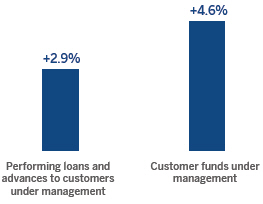 | 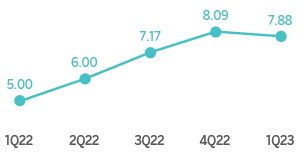 | |||
| (1) Excluding repos. | ||||
OPERATING INCOME (MILLIONS OF EUROS AT CONSTANT EXCHANGE RATES) | NET ATTRIBUTABLE PROFIT (LOSS) (MILLIONS OF EUROS AT CONSTANT EXCHANGE RATES) | |||
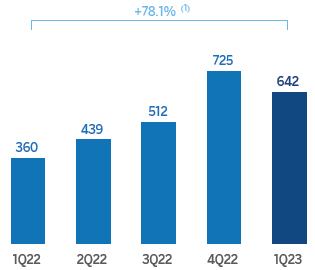 | 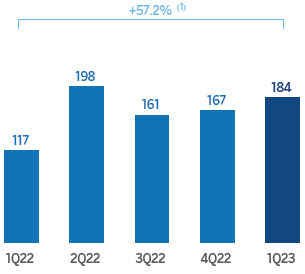 | |||
| (1) At current exchange rates: +35.7%. | (1) At current exchange rates: +14.8%. | |||
| 39 |
FINANCIAL STATEMENTS AND RELEVANT BUSINESS INDICATORS (MILLIONS OF EUROS AND PERCENTAGE) |
| |||||||||||||||
Income statement | 1Q23 | Δ % | Δ % (1) | 1Q22 (2) | ||||||||||||
Net interest income | 1,190 | 47.0 | 81.7 | 809 | ||||||||||||
Net fees and commissions | 184 | 3.4 | 21.0 | 178 | ||||||||||||
Net trading income | 127 | 36.3 | 66.1 | 93 | ||||||||||||
Other operating income and expenses | (326) | 66.9 | 85.3 | (195) | ||||||||||||
Gross income | 1,175 | 32.7 | 66.1 | 885 | ||||||||||||
Operating expenses | (533) | 29.2 | 53.6 | (413) | ||||||||||||
Personnel expenses | (252) | 25.5 | 50.6 | (201) | ||||||||||||
Other administrative expenses | (239) | 34.4 | 61.7 | (177) | ||||||||||||
Depreciation | (43) | 24.0 | 32.1 | (35) | ||||||||||||
Operating income | 642 | 35.7 | 78.1 | 473 | ||||||||||||
Impairment on financial assets not measured at fair value through profit or loss | (227) | 61.2 | 98.2 | (141) | ||||||||||||
Provisions or reversal of provisions and other results | (9) | (45.8) | (38.5) | (16) | ||||||||||||
Profit (loss) before tax | 405 | 28.6 | 75.4 | 315 | ||||||||||||
Income tax | (124) | 38.3 | 94.8 | (89) | ||||||||||||
Profit (loss) for the period | 282 | 24.7 | 68.1 | 226 | ||||||||||||
Non-controlling interests | (98) | 48.7 | 92.9 | (66) | ||||||||||||
Net attributable profit (loss) | 184 | 14.8 | 57.2 | 160 | ||||||||||||
Balance sheets | 31-03-23 | Δ % | Δ % (1) | 31-12-22 | (2) | |||||||||||
Cash, cash balances at central banks and other demand deposits | 7,646 | (0.6) | 2.8 | 7,695 | ||||||||||||
Financial assets designated at fair value | 10,559 | (1.7) | 3.7 | 10,739 | ||||||||||||
Of which: Loans and advances | 61 | (59.6) | (60.4) | 152 | ||||||||||||
Financial assets at amortized cost | 41,734 | 3.2 | 4.4 | 40,448 | ||||||||||||
Of which: Loans and advances to customers | 39,185 | 1.9 | 3.0 | 38,437 | ||||||||||||
Tangible assets | 1,070 | (1.6) | 1.0 | 1,088 | ||||||||||||
Other assets | 2,054 | 3.7 | 4.4 | 1,981 | ||||||||||||
Total assets/liabilities and equity | 63,063 | 1.8 | 4.0 | 61,951 | ||||||||||||
Financial liabilities held for trading and designated at fair value through profit or loss | 2,390 | (15.1) | (16.4) | 2,813 | ||||||||||||
Deposits from central banks and credit institutions | 5,395 | (3.8) | (4.7) | 5,610 | ||||||||||||
Deposits from customers | 40,782 | 1.8 | 4.6 | 40,042 | ||||||||||||
Debt certificates | 3,070 | 3.9 | 3.3 | 2,956 | ||||||||||||
Other liabilities | 5,537 | 18.9 | 26.3 | 4,655 | ||||||||||||
Regulatory capital allocated | 5,889 | 0.2 | 2.4 | 5,874 | ||||||||||||
Relevant business indicators | 31-03-23 | Δ % | Δ % (1) | 31-12-22 | ||||||||||||
Performing loans and advances to customers under management (3) | 39,206 | 1.9 | 2.9 | 38,484 | ||||||||||||
Non-performing loans | 1,929 | 5.1 | 5.2 | 1,835 | ||||||||||||
Customer deposits under management (4) | 40,782 | 1.8 | 4.6 | 40,042 | ||||||||||||
Off-balance sheet funds (5) | 17,971 | 1.2 | 4.7 | 17,760 | ||||||||||||
Risk-weighted assets | 47,341 | 1.1 | 3.1 | 46,834 | ||||||||||||
Efficiency ratio (%) | 45.4 | 46.3 | ||||||||||||||
NPL ratio (%) | 4.3 | 4.1 | ||||||||||||||
NPL coverage ratio (%) | 99 | 101 | ||||||||||||||
Cost of risk (%) | 2.18 | 1.69 | ||||||||||||||
(1) At constant exchange rates.
(2) Restated balances according to IFRS17 - Insurance contracts.
(3) Excluding repos.
(4) Excluding repos and including specific marketable debt securities.
(5) Includes mutual funds, customer portfolios in Colombia and Peru and pension funds.
| 40 |
SOUTH AMERICA. DATA PER COUNTRY (MILLIONS OF EUROS) |
| |||||||||||||||||||||||||||||||||||
| Operating income | Net attributable profit (loss) | |||||||||||||||||||||||||||||||||||
Country | 1Q23 | Δ % | Δ % (1) | 1Q22 (2) | 1Q23 | Δ % | Δ % (1) | 1Q22 (2) | ||||||||||||||||||||||||||||
Argentina | 170 | 106.8 | n.s. | 82 | 52 | 181.9 | n.s. | 18 | ||||||||||||||||||||||||||||
Colombia | 123 | (28.9 | ) | (17.3 | ) | 173 | 41 | (43.3 | ) | (34.0 | ) | 72 | ||||||||||||||||||||||||
Peru | 258 | 37.7 | 32.0 | 187 | 57 | 12.9 | 8.2 | 51 | ||||||||||||||||||||||||||||
Other countries (3) | 90 | 204.5 | 179.1 | 30 | 34 | 75.5 | 63.2 | 19 | ||||||||||||||||||||||||||||
Total | 642 | 35.7 | 78.1 | 473 | 184 | 14.8 | 57.2 | 160 | ||||||||||||||||||||||||||||
(1) Figures at constant exchange rates.
(2) Restated balances according to IFRS17 - Insurance contracts.
(3) Bolivia, Chile (Forum), Uruguay and Venezuela. Additionally, it includes eliminations and other charges.
SOUTH AMERICA. RELEVANT BUSINESS INDICATORS PER COUNTRY (MILLIONS OF EUROS) |
| |||||||||||||||||||||||
| Argentina | Colombia | Peru | ||||||||||||||||||||||
| 31-03-23 | 31-12-22 | 31-03-23 | 31-12-22 | 31-03-23 | 31-12-22 | |||||||||||||||||||
Performing loans and advances to customers under management (1) (2) | 3,854 | 3,183 | 13,723 | 13,541 | 17,033 | 16,804 | ||||||||||||||||||
Non-performing loans (1) | 71 | 53 | 641 | 612 | 1,074 | 1,045 | ||||||||||||||||||
Customer deposits under management (1) (3) | 6,900 | 5,787 | 13,625 | 13,307 | 16,432 | 16,090 | ||||||||||||||||||
Off-balance sheet funds (1) (4) | 2,313 | 1,914 | 2,417 | 2,086 | 1,447 | 1,441 | ||||||||||||||||||
Risk-weighted assets | 7,910 | 8,089 | 15,450 | 15,279 | 18,460 | 17,936 | ||||||||||||||||||
Efficiency ratio (%) | 54.1 | 61.3 | 46.3 | 40.4 | 37.3 | 37.2 | ||||||||||||||||||
NPL ratio (%) | 1.7 | 1.6 | 4.3 | 4.2 | 5.0 | 4.9 | ||||||||||||||||||
NPL coverage ratio (%) | 169 | 173 | 103 | 106 | 90 | 91 | ||||||||||||||||||
Cost of risk (%) | 4.00 | 2.61 | 1.74 | 1.56 | 2.11 | 1.58 | ||||||||||||||||||
(1) Figures at constant exchange rates.
(2) Excluding repos.
(3) Excluding repos and including specific marketable debt securities.
(4) Includes mutual funds and customer portfolios (in Colombia and Peru).
Unless expressly stated otherwise, all the comments below on rates of change, for both activity and results, will be given at constant exchange rates. These rates, together with the changes at current exchange rates, can be found in the attached tables of the financial statements and relevant business indicators.
Activity and results
The most relevant aspects related to the area’s activity during the first quarter of the year 2023 were:
| – | Lending activity (performing loans under management) recorded an increase of 2.9%, with growth focused on the retail portfolio, which grew more than the wholesale portfolio (+4.0% versus +1.9%), favored by the evolution of consumer loans (+4.9%) and credit cards (+10.5%). |
| – | With regard to asset quality, the NPL ratio stood at 4.3%, with an increase of 15 basis points in the quarter at the regional level, although stable in relation to the same period of the previous year. For its part, the area’s NPL coverage ratio stood at 99%. |
| – | Customer funds under management increased (+4.6%) compared to the closing balances at the end of 2022, with higher contribution from time deposits (+15.6%) in an environment of rising benchmark rates and, to a lesser extent, on off-balance sheet funds (+4.7%). |
South America generated a cumulative net attributable profit of €184m at the end of the first quarter of the year 2023, which represents a year-on-year variation of +57.2%, mainly due to the outstanding performance of recurring income (+70.3%) and NTI, which comfortably offset the growth of expenses, in a highly inflationary environment throughout the region, and the higher provisioning requirements for impairment on financial assets.
With regard to the aforementioned inflation impact in Argentina, it stood at €-241m at the end of March 2023, above the €-142m accumulated at the end of March 2022, registered in the “Other operating income and expenses” heading of the area’s income statement.
| 41 |
More detailed information on the most representative countries of the business area is provided below:
Argentina
Macro and industry trends
Despite the less favorable global context and the local environment marked by the difficulty in fixing current macroeconomic distortions and meeting the targets set in the agreement reached with the International Monetary Fund, economic activity showed some dynamism in 2022, with GDP growing by 5.2% in the period, two tenths of a percentage point more than forecast by BBVA Research. However, the most recent data show a significant slowdown in economic activity, in addition to the strong negative impacts of the recent drought on agricultural production and exports. In this context, the forecast for GDP growth in 2023 has been cut from -0.5% three months ago to -2.5%. Moreover, the expectation of GDP contraction in 2023 is supported by the global slowdown, high inflation (94.8% in December 2023, 103,4% in March according to BBVA Research’s forecast, and expected to be around 107% in 2023, on average), financial volatility, limited margin for further stimulus measures and uncertainty about the evolution of economic policy in a presidential election year.
The banking system continues to grow at a steady pace, but remains driven by high inflation. With provisional data as of March 2023, total lending grew by 78.3% compared to the same month in 2022, favored by both consumer and corporate portfolios, reaching growth of 78.0% and 86.0% year-on-year, respectively. For its part, deposits accelerated their growth compared to previous months, increasing by 110% year-on-year according to the provisional data as of March 2023. Finally, the NPL ratio remained stable at 3.21% in January 2023 (113 basic points lower than in the same month in 2022).
Activity and results
| – | In the first quarter of 2023, performing loans under management increased by 21.1%, a figure that is well below inflation, with growth in both the business portfolio (+22.8%) and the retail portfolio (+19.7%), highlighting in the latter credit cards (+16.0%) and consumer loans (+24.7%), the latter driven by the lending campaign to favor the financial inclusion of certain customers. The NPL ratio stood at 1.7%, which represents an increase compared to the previous year (+13 basis points) originating from retail portfolios. For its part, the NPL coverage ratio stood at 169% in the quarter due to the increase in the non-performing loans balance. |
| – | Balance sheet funds grew by 19.2% between January and March 2023, with a similar increase of time and demand deposits, in absolute terms, although the latter increased at a faster rate (+15.3% versus +24.8%). For its part, mutual funds also performed favorably (+20.8%). |
| – | The cumulative net attributable profit at the end of March 2023 stood at €52m, well above the figure achieved in the first quarter of 2022, mainly due to the favorable evolution of the net interest income driven by both volume and price effects, with a clear improvement in customer spread, as well as higher yields on securities portfolios. The year-on-year evolution of net fees and commissions and NTI was also favorable and was partially offset by a more negative adjustment for inflation, higher expenses -both personnel expenses due to salary revisions and general expenses- and loan-loss provisioning. |
Colombia
Macro and industry trends
Economic activity slowed at the end of last year, bringing growth in 2022 to 7.5%, below BBVA Research’s forecast of 8.0%. In addition, high inflation (13.1% in December and 13.3% in March) prompted the Bank of the Republic to raise interest rates to 13% in March. In this context, and taking into account financial volatility and economic policy uncertainty, BBVA Research estimates that interest rates will remain at this contractionary level, or even at a slightly higher level until the fourth quarter of this year, inflation will remain relatively high in 2023 (12.0%, on average) and that growth will decelerate significantly to around 0.7% in 2023 (unchanged from the previous forecast).
Total lending growth in the banking sector stood at 15.4% year-on-year in January 2023, and continues to be driven by corporate credit at 16.6% and lending to households, mainly consumer loans, at 16.6% year-on-year. Moreover, total deposits grew by 14.4% year-on-year at the end of January 2023, characterized by a strong shift towards time deposits (up 54.2% year-on-year) and a slowdown in the growth of demand deposits (to -1.7% year-on-year). The system’s NPL ratio remained stable at around 3.93% in January 2023, a drop of 21 basis points since the same month in 2022.
Activity and results
| – | Lending activity registered a growth of 1.3% compared to the end of 2022. Noteworthy was the performance in the retail portfolio (+2.2%), thanks to the performance of consumer loans and credit cards, while the wholesale portfolio showed stability (+0.2%). In terms of asset quality, the NPL ratio increased in the first quarter of the year (+18 basis points) to 4.3%, originating from retail portfolios, mainly consumer portfolio. For its part, the NPL coverage ratio declined slightly in the quarter to 103%. |
| – | In the first quarter of 2023, customer deposits increased by 2.4% thanks to the positive evolution of time deposits (+13.1%). For its part, off-balance sheet funds recorded a growth of 15.9% between January and March 2023. |
| – | The cumulative net attributable profit at the end of the first quarter of 2023 stood at €41m, that is, 34.0% lower than at the end of the same quarter of the previous year. The lower contribution from net interest income was affected by the high cost of funds and was offset by NTI and net fees and commissions income. On the lower part of the income statement, higher operating expenses and higher provisions for impairment of financial assets. |
| 42 |
Peru
Macro and industry trends
Against a context of political instability, which could have a negative impact on economic activity, GDP expanded by 2.7% in 2022, in line with BBVA Research’s forecast. Moreover, uncertainty about future policies, high inflation, high interest rates and the global economic slowdown will negatively impact growth in 2023, a period for which growth is expected to be around 1.9%, six tenths of a percentage point below the previous forecast. Inflation, which closed 2022 at 8.5% and reached 8.4% in March, would remain high in 2023 (around 6.3%, on average), while official interest rates would remain at the current level of 7.75% in the coming months.
Total credit growth in the Peruvian banking system continued to moderate, reaching 1.8% year-on-year in February 2023. The strongest slowdown continues to be observed in corporate loans, with a balance contraction of 4.7% year-on-year. In contrast, the dynamism of consumer loans remains, with the balance growing by 22.5% year-on-year in February 2023, while the mortgage portfolio maintained a stable growth rate of around 7.3% year-on-year. The system’s total deposits grew slightly (+1.6% year-on-year in February 2023), with a greater shift towards time deposits (+31.0% year-on-year) to the detriment of demand deposits (-8.8% year-on-year). The system’s NPL ratio deteriorated slightly to 3.39% in February 2023 (19 basis points higher than in the same month in 2022).
Activity and results
| – | The quarterly variation of lending activity stood at +1.4% at the end of March 2023, with a favorable evolution of consumer loans (+5.4%) and credit cards (+7.3%) and a flat performance in the business segment (+0.8%), mainly due to the difficulty of offsetting the amortizations of the program Reactiva Peru. Apart from the above, the NPL ratio increased slightly to 5.0%, affected by NPL entries of certain SMEs and other retail portfolios. For its part, the coverage ratio stood at 90%, in line with year-end 2022. |
| – | Customers funds under management increased by 2.0% during the first quarter of 2023, due to the favorable performance of time deposits (+17.2%), supported by the rise in benchmark rates by the central bank, which offset lower balances in demand deposits (-4.0%) and the flat performance of off-balance sheet funds (+0.4%). |
| – | BBVA Peru’s net attributable profit stood at €57m at the end of March 2023, 8.2% higher than the figure achieved at the end of the same quarter of the previous year, driven by recurring income from the banking business, which grew by 28.4%, thanks to the favorable evolution of the net interest income, which benefited from the increase in the customer spread and the higher return on the securities portfolio, and, to a lesser extent, from fees and commissions, and NTI. On the lower part of the income statement, there was an increase in operating expenses (+23.8%) and in the level of provisions for impairment of financial assets (+186.3%), mainly due to higher requirements compared to the previous year in the recurring performance of the portfolio, together with a first quarter of 2022 that included some non-recurring positive elements. |
| 43 |
Highlights
| • | Growth in lending activity in the New York branch and in customer funds |
| • | Recurring income dynamism |
| • | NPL ratio and cost of risk remain at low levels |
| • | Improved efficiency |
BUSINESS ACTIVITY (1) (VARIATION AT CONSTANT EXCHANGE RATES COMPARED TO 31-12-22) | NET INTEREST INCOME / AVERAGE TOTAL ASSETS (PERCENTAGE AT CONSTANT EXCHANGE RATES) | |||
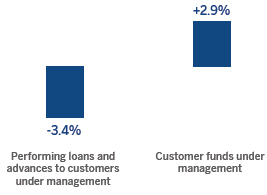 | 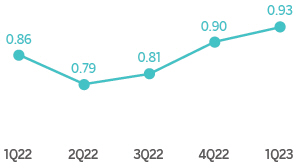 | |||
| (1) Excluding repos. | ||||
OPERATING INCOME (MILLIONS OF EUROS AT CONSTANT EXCHANGE RATES) | NET ATTRIBUTABLE PROFIT (LOSS) (MILLIONS OF EUROS AT CONSTANT EXCHANGE RATES) | |||
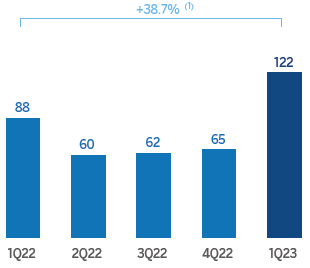 | 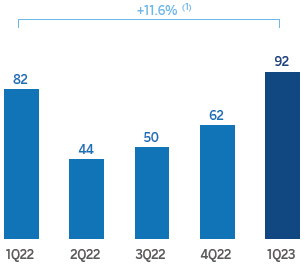 | |||
| (1) At current exchange rates: +39.5%. | (1) At current exchange rates: +12.4%. | |||
| 44 |
FINANCIAL STATEMENTS AND RELEVANT BUSINESS INDICATORS (MILLIONS OF EUROS AND PERCENTAGE) |
| |||||||||||||||
Income statement | 1Q23 | Δ % | Δ % (1) | 1Q22 | ||||||||||||
Net interest income | 113 | 50.3 | 49.4 | 75 | ||||||||||||
Net fees and commissions | 69 | 22.3 | 20.3 | 56 | ||||||||||||
Net trading income | 77 | 12.9 | 12.1 | 68 | ||||||||||||
Other operating income and expenses | 1 | (65.8 | ) | (65.4 | ) | 3 | ||||||||||
Gross income | 260 | 28.5 | 27.3 | 202 | ||||||||||||
Operating expenses | (138 | ) | 20.1 | 18.7 | (115 | ) | ||||||||||
Personnel expenses | (70) | 13.8 | 12.3 | (61) | ||||||||||||
Other administrative expenses | (62) | 28.9 | 27.7 | (48) | ||||||||||||
Depreciation | (6) | 12.6 | 11.6 | (5) | ||||||||||||
Operating income | 122 | 39.5 | 38.7 | 87 | ||||||||||||
Impairment on financial assets not measured at fair value through profit or loss | (18 | ) | n.s. | n.s. | 7 | |||||||||||
Provisions or reversal of provisions and other results | 7 | (24.5 | ) | (26.0 | ) | 10 | ||||||||||
Profit (loss) before tax | 111 | 6.0 | 5.2 | 105 | ||||||||||||
Income tax | (19 | ) | (16.7 | ) | (17.2 | ) | (23 | ) | ||||||||
Profit (loss) for the period | 92 | 12.4 | 11.6 | 81 | ||||||||||||
Non-controlling interests | — | — | — | — | ||||||||||||
Net attributable profit (loss) | 92 | 12.4 | 11.6 | 81 | ||||||||||||
Balance sheets | 31-03-23 | Δ % | Δ % (1) | 31-12-22 | ||||||||||||
Cash, cash balances at central banks and other demand deposits | 4,135 | 3.0 | 4.9 | 4,015 | ||||||||||||
Financial assets designated at fair value | 6,652 | 30.7 | 33.0 | 5,090 | ||||||||||||
Of which: Loans and advances | 5,877 | 38.9 | 41.6 | 4,230 | ||||||||||||
Financial assets at amortized cost | 39,167 | (3.1 | ) | (2.6 | ) | 40,425 | ||||||||||
Of which: Loans and advances to customers | 35,946 | (3.8) | (3.3) | 37,375 | ||||||||||||
Inter-area positions | — | — | — | — | ||||||||||||
Tangible assets | 75 | (4.3 | ) | (4.0 | ) | 78 | ||||||||||
Other assets | 379 | 10.3 | 11.6 | 343 | ||||||||||||
Total assets/liabilities and equity | 50,407 | 0.9 | 1.7 | 49,952 | ||||||||||||
Financial liabilities held for trading and designated at fair value through profit or loss | 5,942 | 35.1 | 37.8 | 4,397 | ||||||||||||
Deposits from central banks and credit institutions | 1,777 | (35.3 | ) | (34.7 | ) | 2,745 | ||||||||||
Deposits from customers | 10,070 | 2.5 | 3.2 | 9,827 | ||||||||||||
Debt certificates | 1,453 | (6.9 | ) | (6.3 | ) | 1,561 | ||||||||||
Inter-area positions | 25,945 | (0.4 | ) | 0.2 | 26,060 | |||||||||||
Other liabilities | 1,039 | 2.5 | 3.6 | 1,014 | ||||||||||||
Regulatory capital allocated | 4,182 | (3.8 | ) | (3.2 | ) | 4,348 | ||||||||||
Relevant business indicators | 31-03-23 | Δ % | Δ % (1) | 31-12-22 | ||||||||||||
Performing loans and advances to customers under management (2) | 35,946 | (4.0 | ) | (3.4 | ) | 37,431 | ||||||||||
Non-performing loans | 252 | 31.0 | 31.0 | 192 | ||||||||||||
Customer deposits under management (2) | 10,070 | 2.5 | 3.2 | 9,827 | ||||||||||||
Off-balance sheet funds (3) | 510 | (1.9 | ) | (1.9 | ) | 520 | ||||||||||
Risk-weighted assets | 33,725 | (3.8 | ) | (3.2 | ) | 35,064 | ||||||||||
Efficiency ratio (%) | 53.1 | 65.0 | ||||||||||||||
NPL ratio (%) | 0.5 | 0.4 | ||||||||||||||
NPL coverage ratio (%) | 101 | 131 | ||||||||||||||
Cost of risk (%) | 0.21 | 0.04 | ||||||||||||||
(1) At constant exchange rates.
(2) Excluding repos.
(3) Includes pension funds.
| 45 |
Unless expressly stated otherwise, all the comments below on rates of change, for both activity and results, will be given at constant exchange rates. These rates, together with the changes at current exchange rates, can be found in the attached tables of the financial statements and relevant business indicators. Comments that refer to Europe exclude Spain.
Activity
The most relevant aspects of the evolution of BBVA Group’s Rest of Business activity between January and March 2023 were:
| – | Lending activity (performing loans under management) registered a decrease (-3.4%), due to the performance of the branches in Asia and Europe which was offset by the favorable performance of the New York branch. |
| – | Regarding credit risk indicators, the NPL ratio stood at 0.5%, higher than at the end of the previous year (+13 basis points), mainly due to the entry of a one-off customer. |
| – | Customer funds under management grew by 2.9%, thanks to the growth in time deposits in the New York branch and in Asia, more than offsetting the decline in demand deposits and off-balance sheet funds. |
Results
Rest of Business achieved a net attributable profit of €92m accumulated at the end of the first quarter of 2023, 11.6% higher than in the same period of the previous year, thanks to a favorable performance of recurring income and NTI, which offset the increase in expenses in a context of higher inflation and a normalization of loan-loss provisions.
The year-on-year evolution of the main lines of the area’s income statement at the end of March 2023 was particularly noteworthy:
| – | The net interest income improved 49.4%, as a result of generalized interest rate hikes by central banks in the geographic areas included in this aggregate, as well as the higher volume of loans under management. Particularly noteworthy was the performance in Europe and the New York branch. |
| – | Net fees and commissions increased (+20.3%), with a good performance especially in the New York office, BBVA Securities and, to a lesser extent, the CIB business in Asia, which offset lower fees and commissions recorded in Europe. |
| – | The NTI line grew by 12.1%, supported by the results of BBVA Securities and, to a lesser extent, Global Markets in Asia and Europe. |
| – | Increase in operating expenses of 18.7%, mainly due to higher general and personnel expenses, mainly in Europe and the New York branch. |
| – | The impairment on financial assets line closed March 2023 with a slight provision compared to the release of the previous year, mainly originated in Europe. |
| – | The provisions or reversal of provisions line and other results decreased by 26.0% due to lower releases compared to the same period of the previous year. |
| – | As a result, the area’s cumulative net attributable profit between January and March 2023 was €92m (+11.6% year-on-year). |
| 46 |
FINANCIAL STATEMENTS (MILLIONS OF EUROS AND PERCENTAGE) |
| |||||||||||
| Income statement | 1Q23 | Δ % | 1Q22 | |||||||||
| Net interest income | (60 | ) | 60.8 | (37 | ) | |||||||
| Net fees and commissions | (4 | ) | 1.4 | (4 | ) | |||||||
| Net trading income | (258 | ) | n.s. | (38 | ) | |||||||
| Other operating income and expenses | 11 | n.s. | 1 | |||||||||
| Gross income | (311 | ) | 293.0 | (79 | ) | |||||||
| Operating expenses | (205 | ) | 9.7 | (187 | ) | |||||||
Personnel expenses | (151 | ) | 15.9 | (130 | ) | |||||||
Other administrative expenses | (4 | ) | (54.1 | ) | (9 | ) | ||||||
Depreciation | (50 | ) | 4.2 | (48 | ) | |||||||
| Operating income | (516 | ) | 93.8 | (266 | ) | |||||||
| Impairment on financial assets not measured at fair value through profit or loss | 0 | (81.0 | ) | 1 | ||||||||
| Provisions or reversal of provisions and other results | (3 | ) | n.s. | 11 | ||||||||
| Profit (loss) before tax | (519 | ) | 103.5 | (255 | ) | |||||||
| Income tax | (9 | ) | n.s. | 46 | ||||||||
| Profit (loss) for the period | (528 | ) | 152.8 | (209 | ) | |||||||
| Non-controlling interests | (3 | ) | (44.2 | ) | (6 | ) | ||||||
Net attributable profit (loss) | (531 | ) | 147.0 | (215 | ) | |||||||
| Balance sheets | 31-03-23 | Δ % | 31-12-22 | |||||||||
| Cash, cash balances at central banks and other demand deposits | 566 | (33.9 | ) | 856 | ||||||||
| Financial assets designated at fair value | 2,427 | 1.5 | 2,390 | |||||||||
Of which: Loans and advances | — | — | — | |||||||||
| Financial assets at amortized cost | 3,742 | 14.7 | 3,262 | |||||||||
Of which: Loans and advances to customers | 402 | 44.7 | 278 | |||||||||
Inter-area positions | — | — | — | |||||||||
Tangible assets | 1,754 | (5.8 | ) | 1,863 | ||||||||
Other assets | 13,907 | (3.1 | ) | 14,349 | ||||||||
Total assets/liabilities and equity | 22,396 | (1.4) | 22,719 | |||||||||
Financial liabilities held for trading and designated at fair value through profit or loss | 305 | 182.0 | 108 | |||||||||
Deposits from central banks and credit institutions | 698 | 2.4 | 682 | |||||||||
Deposits from customers | 186 | (0.2 | ) | 187 | ||||||||
Debt certificates | (2,057 | ) | 138.4 | (863 | ) | |||||||
Inter-area positions | 6,786 | (14.8 | ) | 7,963 | ||||||||
Other liabilities | 5,918 | 47.5 | 4,011 | |||||||||
Regulatory capital allocated | (40,913 | ) | 2.6 | (39,887 | ) | |||||||
Total equity | 51,471 | 1.9 | 50,517 | |||||||||
Results
The Corporate Center recorded a net attributable profit of €-531m in the first quarter of the year 2023, compared with €-215m recorded in the same period of the previous year, mainly due to a negative contribution in the NTI line from exchange rate hedges as a result of better than expected currency performance, in particular the Mexican peso.
The Corporate Center’s tax expense reflects the difference between the effective tax rate in the period for each business area and the Group’s expected tax rate for the year as a whole. In this quarter the tax expense is negative basically due to the one-off positive effect of the tax change in Turkey.
| 47 |
Other information: Corporate & Investment Banking
Highlights
| • | Slowdown in lending activity and growth in customer funds in the quarter |
| • | Favorable evolution of recurrent revenues and excellent NTI performance |
| • | Improvement in efficiency |
| • | Outstanding performance of net attributable profit |
BUSINESS ACTIVITY (1) (VARIATION AT CONSTANT EXCHANGE RATES COMPARED TO 31-12-22) | GROSS INCOME / AVERAGE TOTAL ASSETS (PERCENTAGE AT CONSTANT EXCHANGE RATES) | |||
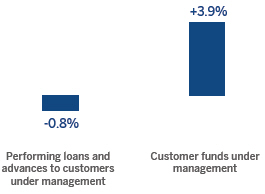 | 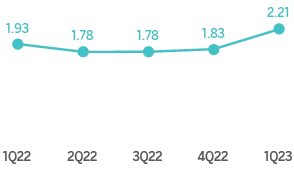 | |||
| (1) Excluding repos. | ||||
OPERATING INCOME (MILLIONS OF EUROS AT CONSTANT EXCHANGE RATES) | NET ATTRIBUTABLE PROFIT (LOSS) (MILLIONS OF EUROS AT CONSTANT EXCHANGE RATES) | |||
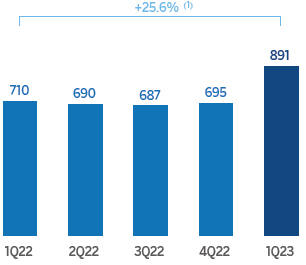 | 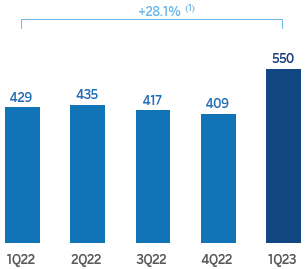 | |||
| (1) At current exchange rates: +20.6%. | (1) At current exchange rates: +26.4%. | |||
| 48 |
FINANCIAL STATEMENTS AND RELEVANT BUSINESS INDICATORS (MILLIONS OF EUROS AND PERCENTAGE) |
| |||||||||||||||
Income statement | 1Q23 (1) | Δ % | Δ % (2) | 1Q22 | ||||||||||||
Net interest income | 516 | 11.6 | 13.2 | 463 | ||||||||||||
Net fees and commissions | 276 | 39.3 | 40.4 | 198 | ||||||||||||
Net trading income | 431 | 25.3 | 34.4 | 344 | ||||||||||||
Other operating income and expenses | (28 | ) | 250.0 | 245.8 | (8 | ) | ||||||||||
Gross income | 1,195 | 19.9 | 23.8 | 997 | ||||||||||||
Operating expenses | (304 | ) | 17.9 | 19.0 | (258 | ) | ||||||||||
Personnel expenses | (143) | 19.4 | 19.3 | (120) | ||||||||||||
Other administrative expenses | (136) | 20.4 | 23.5 | (113) | ||||||||||||
Depreciation | (26) | — | (1.8) | (26) | ||||||||||||
Operating income | 891 | 20.6 | 25.6 | 739 | ||||||||||||
Impairment on financial assets not measured at fair value through profit or loss | (44 | ) | 113.7 | 99.5 | (20 | ) | ||||||||||
Provisions or reversal of provisions and other results | 15 | (19.7 | ) | (19.8 | ) | 19 | ||||||||||
Profit (loss) before tax | 862 | 17.0 | 22.1 | 737 | ||||||||||||
Income tax | (239 | ) | 14.8 | 20.0 | (208 | ) | ||||||||||
Profit (loss) for the period | 623 | 17.8 | 22.9 | 528 | ||||||||||||
Non-controlling interests | (73 | ) | (21.8 | ) | (5.9 | ) | (94 | ) | ||||||||
Net attributable profit (loss) | 550 | 26.4 | 28.1 | 435 | ||||||||||||
Balance sheets | 31-03-23 | Δ % | Δ % (2) | 31-12-22 | ||||||||||||
Cash, cash balances at central banks and other demand deposits | 4,820 | (12.7 | ) | (11.9 | ) | 5,524 | ||||||||||
Financial assets designated at fair value | 130,792 | 10.9 | 10.3 | 117,958 | ||||||||||||
Of which: Loans and advances | 53,662 | 18.3 | 18.4 | 45,360 | ||||||||||||
Financial assets at amortized cost | 90,375 | 1.0 | 0.7 | 89,440 | ||||||||||||
Of which: Loans and advances to customers | 76,859 | (0.5) | (0.8) | 77,208 | ||||||||||||
Inter-area positions | — | — | — | — | ||||||||||||
Tangible assets | 54 | 4.8 | 3.9 | 52 | ||||||||||||
Other assets | 1,919 | 122.6 | 157.8 | 862 | ||||||||||||
Total assets/liabilities and equity | 227,960 | 6.6 | 6.2 | 213,836 | ||||||||||||
Financial liabilities held for trading and designated at fair value through profit or loss | 105,432 | 6.7 | 6.2 | 98,790 | ||||||||||||
Deposits from central banks and credit institutions | 25,158 | 19.9 | 19.6 | 20,987 | ||||||||||||
Deposits from customers | 53,258 | 10.5 | 10.0 | 48,180 | ||||||||||||
Debt certificates | 5,831 | 10.2 | 9.5 | 5,292 | ||||||||||||
Inter-area positions | 21,979 | (14.2 | ) | (14.4 | ) | 25,609 | ||||||||||
Other liabilities | 5,539 | 34.3 | 30.5 | 4,124 | ||||||||||||
Regulatory capital allocated | 10,762 | (0.9 | ) | 0.6 | 10,855 | |||||||||||
Relevant business indicators | 31-03-23 | Δ % | Δ % (2) | 31-12-22 | ||||||||||||
Performing loans and advances to customers under management (3) | 76,884 | (0.5 | ) | (0.8 | ) | 77,291 | ||||||||||
Non-performing loans | 817 | 8.4 | 11.6 | 753 | ||||||||||||
Customer deposits under management (3) | 48,069 | 1.7 | 1.2 | 47,270 | ||||||||||||
Off-balance sheet funds (4) | 3,009 | 71.9 | 84.0 | 1,750 | ||||||||||||
Efficiency ratio (%) | 25.5 | 28.5 | ||||||||||||||
(1) For the translation of the income statement in those countries where hyperinflation accounting is applied, the punctual exchange rate as of March 31, 2023 is used.
(2) At constant exchange rates.
(3) Excluding repos.
(4) Includes mutual funds, customer portfolios and other off-balance sheet funds.
| 49 |
Unless expressly stated otherwise, all the comments below on rates of change, for both activity and results, will be given at constant exchange rates. For the conversion of these figures in those countries in which accounting for hyperinflation is applied, the punctual exchange rate as of March 31, 2023 is used. These rates, together with changes at current exchange rates, can be found in the attached tables of financial statements and relevant business indicators.
Activity
The most relevant aspects related to the area’s activity in the first quarter of 2023 were:
| – | Lending activity (performing loans under management) slowed down by -0.8% since December 2022, as a result of the volume of new operations and renewals which did not offset the quarter’s maturities, due to an environment of excess liquidity that makes it difficult to maintain the volumes of previous quarters, especially in transactional banking (Global Transactional Banking). Of note by products was the evolution of Investment Banking & Finance and by geographic areas, particularly the increase in the New York branch’s operations. |
| – | Customer funds continued to grow compared to December (+3.9%) but in a less dynamic way compared to previous quarters as a result of lower lending activity, maintaining the positive trend in price management. |
Results
CIB generated a net attributable profit of €550m in the first quarter of 2023. These results, which do not include the application of hyperinflation accounting, represent an increase of 28.1% on a year-on-year basis, due to the growth in recurring income and NTI, which comfortably offset the higher expenses and provisions for impairment on financial assets, highlighting the contribution of Global Transactional Banking.
The contribution by business areas, excluding the Corporate Center, to CIB’s accumulated net attributable profit at the end of March 2023 was as follows: 19% Spain, 26% Mexico, 25% Turkey, 16% South America and 15% Rest of Business.
The most relevant aspects of the year-on-year evolution in the income statement of this aggregate are summarized below:
| – | Net interest income was 13.2% higher than in the same period last year, due to the good year-on-year performance of the business, mainly in Global Transactional Banking and the positive trend in price management. |
| – | Net fees and commissions grew by 40.4%, with positive evolution of all business lines, especially in Global Markets, benefited from an increase in operations in the primary debt market and Global Transactional Banking, particularly in Mexico due to commissions linked to collections, payments and liquidity. By geographical areas, all had a favorable evolution with double-digit growth. By geographic area, all had a favorable evolution with double-digit growth. |
| – | Excellent NTI performance (+34.4%), mainly due to the performance of the Global Markets unit driven by the income generated by the volatility of the markets, as well as the intraday trading of currency positions. As for the geographical areas, all except Spain grew at double digits. |
| – | Operating expenses increased by 19.0%, with higher personnel expenses, partly due to measures taken by the Group to compensate for the loss in purchasing power of the workforce. For its part, general expenses continued to be affected by the current inflationary environment. Despite the aforementioned, the efficiency ratio stood at 25.5%, which is an improvement over the same period last year. |
| – | Higher level of provisions for impairment on financial assets, with higher loan loss-provisions in Turkey and, to a lesser extent, in Europe. |
| 50 |
Alternative Performance Measures (APMs)
BBVA presents its results in accordance with the International Financial Reporting Standards (EU-IFRS). Additionally, the Group also considers that some Alternative Performance Measures (hereinafter APMs) provide useful additional financial information that should be taken into account when evaluating performance. These APMs are also used when making financial, operational and planning decisions within the Entity. The Group firmly believes that they give a true and fair view of its financial information. These APMs are generally used in the financial sector as indicators for monitoring the assets, liabilities and economic and financial situation of entities.
BBVA Group’s APMs are given below. They are presented in accordance with the European Securities and Markets Authority (ESMA) guidelines, published on October 5, 2015 (ESMA/2015/1415en). The guideline mentioned before is aimed at promoting the usefulness and transparency of APMs included in prospectuses or regulated information in order to protect investors in the European Union. In accordance with the indications given in the aforementioned guideline, BBVA Group’s APMs:
| – | Include clear and readable definitions of the APMs. |
| – | Disclose the reconciliations to the most directly reconcilable line item, subtotal or total presented in the financial statements of the corresponding period, separately identifying and explaining the material reconciling items. |
| – | Are standard measures generally used in the financial industry, so their use provides comparability in the analysis of performance between issuers. |
| – | Do not have greater preponderance than measures directly stemming from financial statements. |
| – | Are accompanied by comparatives for previous periods. |
| – | Are consistent over time. |
Constant exchange rates
When comparing two dates or periods in this management report, the impact of changes in the exchange rates against the euro of the currencies of the countries in which BBVA operates is sometimes excluded, assuming that exchange rates remain constant. This is done for the amounts in the income statement by using the average exchange rate against the euro in the most recent period for each currency9 of the geographical areas in which the Group operates, and applying it to both periods; for amounts in the balance sheet and activity, the closing exchange rates in the most recent period are used.
Adjusted profit (loss) for the period (excluding non-recurring impacts)
Explanation of the formula: the adjusted profit (loss) for the period is defined as the profit (loss) for the period from the Group’s consolidated income statement, excluding those non-recurring impacts that, for management purposes, are defined at any given moment. If the described metric is presented on a date prior to the end of the year, it will be presented on an annualized basis.
Relevance of its use: this measure is commonly used, not only in the banking sector, for homogeneous comparison purposes.
Adjusted profit (loss) for the period |
| |||||||||||||||||
| Jan.-Mar.2023 | Jan.-Dec.2022 | Jan.-Mar.2022 | ||||||||||||||||
(Millions of euros) | + | Annualized profit (loss) after tax | 8,088 | 6,763 | 5,359 | |||||||||||||
(Millions of euros) | - | Net impact arisen from the purchase of offices in Spain | — | (201 | ) | — | ||||||||||||
= | Adjusted profit (loss) for the period | 8,088 | 6,965 | 5,359 | ||||||||||||||
Adjusted net attributable profit (loss) (excluding non-recurring impacts)
Explanation of the formula: the adjusted net attributable profit (loss) is defined as the net attributable profit (loss) of the Group’s consolidated income statement excluding those non-recurring impacts that, for management purposes are defined at any given moment. If the described metric is presented on a date prior to the end of the year, it will be presented on an annualized basis.
Relevance of its use: this measure is commonly used, not only in the banking sector, for comparison purposes.
Adjusted net attributable profit (loss) |
| |||||||||||||||||
| Jan.-Mar.2023 | Jan.-Dec.2022 | Jan.-Mar.2022 | ||||||||||||||||
(Millions of euros) | + | Annualized net attributable profit (loss) | 7,488 | 6,358 | 5,373 | |||||||||||||
(Millions of euros) | - | Net impact arisen from the purchase of offices in Spain | — | (201 | ) | — | ||||||||||||
= | Adjusted net attributable profit (loss) | 7,488 | 6,559 | 5,373 | ||||||||||||||
9 With the exception of those countries whose economies have been considered hyperinflationary, for which the closing exchange rate of the most recent period will be used.
| 51 |
ROE
The ROE (return on equity) ratio measures the accounting return obtained on an entity’s shareholders’ funds plus accumulated other comprehensive income. It is calculated as follows:
| Net attributable profit (loss) | ||||
| Average shareholders’ funds + Average accumulated other comprehensive income |
Explanation of the formula: the numerator is the net attributable profit (loss) of the Group’s consolidated income statement. If the metric is presented on a date before the close of the fiscal year, the numerator will be annualized.
Average shareholders’ funds are the weighted moving average of the shareholders’ funds at the end of each month of the period analyzed, adjusted to take into account the execution of the “dividend-option” at the closing dates on which it was agreed to deliver this type of dividend prior to the publication of the Group’s results.
Average accumulated other comprehensive income is the moving weighted average of “Accumulated other comprehensive income”, which is part of the equity on the Entity’s balance sheet and is calculated in the same way as average shareholders’ funds (above).
Relevance of its use: this ratio is very commonly used not only in the banking sector but also in other sectors to measure the return obtained on shareholders’ funds.
ROE |
| |||||||||||||||
| Jan.-Mar.2023 | Jan.-Dec.2022 | Jan.-Mar.2022 | ||||||||||||||
Numerator (Millions of euros) | = | Annualized net attributable profit (loss) | 7,488 | 6,358 | 5,373 | |||||||||||
Denominator (Millions of euros) | + | Average shareholder’s funds | 64,967 | 61,517 | 59,257 | |||||||||||
| + | Average accumulated other comprehensive income | (16,811) | (16,055) | (14,746) | ||||||||||||
| = | ROE | 15.5 % | 14.0 % | 12.1 % | ||||||||||||
Adjusted ROE
The adjusted ROE (return on equity) ratio measures the return obtained on an entity’s shareholders’ funds plus accumulated other comprehensive income. It is calculated as follows:
| Adjusted net attributable profit (loss) |
| Average shareholders’ funds + Average accumulated other comprehensive income |
Explanation of the formula: the numerator is the adjusted net attributable profit (loss) previously defined in these alternative performance measures. If the metric is presented on a date before the close of the fiscal year, the numerator will be annualized. The denominator items “Average shareholders’ funds” and “Average accumulated other comprehensive income” are the same and they are calculated in the same way as that explained for ROE.
Relevance of its use: this ratio is very commonly used not only in the banking sector but also in other sectors to measure the return obtained on shareholders’ funds.
Adjusted ROE |
| |||||||||||||||
| Jan.-Mar.2023 | Jan.-Dec.2022 | Jan.-Mar.2022 | ||||||||||||||
Numerator (Millions of euros) | = | Annualized adjusted net attributable profit (loss) | 7,488 | 6,559 | 5,373 | |||||||||||
Denominator (Millions of euros) | + | Average shareholder’s funds | 64,967 | 61,517 | 59,257 | |||||||||||
| + | Average accumulated other comprehensive income | (16,811) | (16,055) | (14,746) | ||||||||||||
| = | Adjusted ROE | 15.5 % | 14.4 % | 12.1 % | ||||||||||||
ROTE
The ROTE (return on tangible equity) ratio measures the accounting return on an entity’s shareholders’ funds, plus accumulated other comprehensive income, and excluding intangible assets. It is calculated as follows:
Net attributable profit (loss)
Average shareholders’ funds + Average accumulated other comprehensive income - Average intangible assets
| 52 |
Explanation of the formula: the numerator “Net attributable profit (loss)” and the items in the denominator “Average intangible assets” and “Average accumulated other comprehensive income” are the same items and are calculated in the same way as explained for ROE.
Average intangible assets are the intangible assets on the Group’s consolidated balance sheet, including goodwill and other intangible assets. The average balance is calculated in the same way as explained for shareholders funds in ROE.
Relevance of its use: this metric is generally used not only in the banking sector but also in other sectors to measure the return obtained on shareholders’ funds, not including intangible assets.
ROTE |
| |||||||||||||||
| Jan.-Mar.2023 | Jan.-Dec.2022 | Jan.-Mar.2022 | ||||||||||||||
Numerator (Millions of euros) | = | Annualized net attributable profit (loss) | 7,488 | 6,358 | 5,373 | |||||||||||
Denominator (Millions of euros) | + | Average shareholder’s funds | 64,967 | 61,517 | 59,257 | |||||||||||
| + | Average accumulated other comprehensive income | (16,811) | (16,055) | (14,746) | ||||||||||||
| - | Average intangible assets | 2,170 | 2,119 | 2,036 | ||||||||||||
| = | ROTE | 16.3 % | 14.7 % | 12.6 % | ||||||||||||
Adjusted ROTE
The adjusted ROTE (return on tangible equity) ratio measures the return on an entity’s shareholders’ funds, plus accumulated other comprehensive income, and excluding intangible assets. It is calculated as follows:
Adjusted net attributable profit (loss)
Average shareholders’ funds + Average accumulated other comprehensive income - Average intangible assets
Explanation of the formula: the numerator “Adjusted net attributable profit (loss)” is the same and is calculated in the same way as explained for adjusted ROE, and the items of the denominator “Average shareholders’ funds” and “ Average accumulated other comprehensive income” are the same and are calculated in the same way as explained for ROE.
Average intangible assets are the intangible assets on the Group’s consolidated balance sheet, which include goodwill and other intangible assets. The average balance is calculated in the same way as explained for shareholders’ funds in the ROE.
Relevance of its use: this metric is generally used not only in the banking sector but also in other sectors to measure the return obtained on shareholders’ funds, not including intangible assets.
Adjusted ROTE |
| |||||||||||||||
| Jan.-Mar.2023 | Jan.-Dec.2022 | Jan.-Mar.2022 | ||||||||||||||
Numerator (Millions of euros) | = | Annualized adjusted net attributable profit (loss) | 7,488 | 6,559 | 5,373 | |||||||||||
Denominator (Millions of euros) | + | Average shareholder’s funds | 64,967 | 61,517 | 59,257 | |||||||||||
| + | Average accumulated other comprehensive income | (16,811) | (16,055) | (14,746) | ||||||||||||
| - | Average intangible assets | 2,170 | 2,119 | 2,036 | ||||||||||||
| = | Adjusted ROTE | 16.3 % | 15.1 % | 12.6 % | ||||||||||||
ROA
The ROA (return on assets) ratio measures the accounting return obtained on an entity’s assets. It is calculated as follows:
Profit (loss) for the period
Average total assets
Explanation of the formula: the numerator is the profit (loss) for the period of the Group’s consolidated income statement. If the metric is presented on a date before the close of the fiscal year, the numerator must be annualized.
Average total assets are taken from the Group’s consolidated balance sheet. The average balance is calculated as explained for average shareholders’ funds in the ROE.
Relevance of its use: this ratio is generally used not only in the banking sector but also in other sectors to measure the return obtained on assets.
| 53 |
ROA | ||||||||
| Jan.-Mar.2023 | Jan.-Dec.2022 | Jan.-Mar.2022 | ||||||
Numerator (Millions of euros) | Annualized profit (loss) for the period | 8,088 | 6,763 | 5,359 | ||||
Denominator (Millions of euros) | Average total assets | 726,032 | 701,093 | 658,681 | ||||
= | ROA | 1.11 % | 0.96 % | 0.81 % | ||||
Adjusted ROA
The adjusted ROA (return on assets) ratio measures the return obtained on an entity’s assets. It is calculated as follows:
Adjusted profit (loss) for the period
Average total assets
Explanation of the formula: the numerator is the adjusted profit (loss) for the period previously defined in these alternative performance measures. If the metric is presented on a date before the close of the fiscal year, the numerator will be annualized.
Average total assets are taken from the Group’s consolidated balance sheet. The average balance is calculated in the same way as explained for average equity in the ROE.
Relevance of its use: this ratio is generally used not only in the banking sector but also in other sectors to measure the return obtained on assets.
Adjusted ROA | ||||||||
| Jan.-Mar.2023 | Jan.-Dec.2022 | Jan.-Mar.2022 | ||||||
Numerator (Millions of euros) | Annualized adjusted profit (loss) for the period | 8,088 | 6,965 | 5,359 | ||||
Denominator (Millions of euros) | Average total assets | 726,032 | 701,093 | 658,681 | ||||
= | Adjusted ROA | 1.11 % | 0.99 % | 0.81 % | ||||
RORWA
The RORWA (return on risk-weighted assets) ratio measures the accounting return obtained on average risk-weighted assets. It is calculated as follows:
Profit (loss) for the period
Average risk-weighted assets
Explanation of the formula: the numerator “Profit (loss) for the period” is the same and is calculated in the same way as explained for ROA.
Average risk-weighted assets (RWA) are the moving weighted average of the RWA at the end of each month of the period under analysis.
Relevance of its use: this ratio is generally used in the banking sector to measure the return obtained on RWA.
RORWA | ||||||||
| Jan.-Mar.2023 | Jan.-Dec.2022 | Jan.-Mar.2022 | ||||||
Numerator (Millions of euros) | Annualized profit (loss) for the period | 8,088 | 6,763 | 5,359 | ||||
Denominator (Millions of euros) | Average RWA | 342,154 | 327,998 | 310,971 | ||||
= | RORWA | 2.36 % | 2.06 % | 1.72 % | ||||
Adjusted RORWA
The adjusted RORWA (return on risk-weighted assets) ratio measures the return obtained on an entity’s assets. It is calculated as follows:
Adjusted profit (loss) for the period
Average risk-weighted assets
| 54 |
Explanation of the formula: the numerator “Adjusted profit (loss) for the period” is the same and is calculated in the same way as explained for adjusted ROA.
Average risk-weighted assets (RWA) are the moving weighted average of the risk-weighted assets at the end of each month of the period under analysis.
Relevance of its use: this ratio is generally used not only in the banking sector but also in other sectors to measure the return obtained on assets.
Adjusted RORWA | ||||||||
| Jan.-Mar.2023 | Jan.-Dec.2022 | Jan.-Mar.2022 | ||||||
Numerator (Millions of euros) | Annualized adjusted profit (loss) for the period | 8,088 | 6,965 | 5,359 | ||||
| Denominator (Millions of euros) | Average RWA | 342,154 | 327,998 | 310,971 | ||||
= | Adjusted RORWA | 2.36 % | 2.12 % | 1.72 % | ||||
Earning (loss) per share
The earning (loss) per share is calculated in accordance to the criteria established in the IAS 33 “Earnings per share”.
Earning (loss) per share |
| |||||||||||||||
| Jan.-Mar.2023 | Jan.-Dec.2022 | Jan.-Mar.2022 | ||||||||||||||
(Millions of euros) | + | Net attributable profit (loss) | 1,846 | 6,358 | 1,325 | |||||||||||
(Millions of euros) | - | Remuneration related to the Additional Tier 1 securities (CoCos) | 74 | 313 | 80 | |||||||||||
| Numerator (millions of euros) | = | Net attributable profit (loss) ex.CoCos remuneration | 1,772 | 6,045 | 1,244 | |||||||||||
Denominator (millions) | + | Average number of shares issued | 6,030 | 6,424 | 6,668 | |||||||||||
| - | Average treasury shares of the period | 9 | 9 | 14 | ||||||||||||
| - | Share buyback program (average) | 2 | 225 | 207 | ||||||||||||
| = | Earning (loss) per share (euros) | 0.29 | 0.98 | 0.19 | ||||||||||||
Additionally, for management purposes, earning (loss) per share is presented excluding non-recurring impacts. Specifically, during the period January-December 2022 the net impact from the purchase of offices in Spain in the second quarter of 2022 is excluded.
Adjusted earning (loss) per share |
| |||||||||||||||
| Jan.-Mar.2023 | Jan.-Dec.2022 | Jan.-Mar.2022 | ||||||||||||||
(Millions of euros) | + | Net attributable profit (loss) ex. CoCos remuneration | 1,772 | 6,045 | 1,244 | |||||||||||
(Millions of euros) | - | Net impact arisen from the purchase of offices in Spain | — | (201) | — | |||||||||||
Numerator (millions of euros) | = | Net Attributable profit (loss) ex.CoCos and non-recurring impacts | 1,772 | 6,246 | 1,244 | |||||||||||
Denominator (millions) | + | Number of shares issued (1) | 6,030 | 6,030 | 6,030 | |||||||||||
| - | Average treasury shares of the period (2) | 11 | 9 | 14 | ||||||||||||
| = | Adjusted earning (loss) per share (euros) | 0.29 | 1.04 | 0.21 | ||||||||||||
(1) In the period January-December 2022 and January-March 2022, the number of shares issued takes into account the total redemption of the first share buyback program.
(2) The period January-March 2023 includes 2 million shares corresponding to the average number of shares acquired through March 31, 2023, in execution of the share buyback program announced on February 1, 2023.
Efficiency ratio
This measures the percentage of gross income consumed by an entity’s operating expenses. It is calculated as follows:
Operating expenses
Gross income
Explanation of the formula: both “Operating expenses” and “Gross income” are taken from the Group’s consolidated income statement. Operating expenses are the sum of the administration costs (personnel expenses plus other administrative expenses) plus depreciation. Gross income is the sum of net interest income, net fees and commissions, net trading income dividend income, share of profit or loss of entities accounted for using the equity method, other operating income and expenses, and income from assets and expenses from liabilities under insurance and reinsurance contracts. For a more detailed calculation of this ratio, the graphs on “Results” section of this report should be consulted, one of them with calculations with figures at current exchange rates and another with the data at constant exchange rates.
| 55 |
Relevance of its use: this ratio is generally used in the banking sector. In addition, it is the metric for one of the six Strategic Priorities of the Group.
Efficiency ratio | ||||||||
| Jan.-Mar.2023 | Jan.-Dec.2022 | Jan.-Mar.2022 | ||||||
Numerator (Millions of euros) | + Operating expenses | 3,016 | 10,701 | 2,406 | ||||
Denominator (Millions of euros) | + Gross income | 6,958 | 24,743 | 5,395 | ||||
= Efficiency ratio | 43.3 % | 43.2 % | 44.6 % | |||||
Dividend yield
This is the remuneration given to the shareholders in the last twelve calendar months, divided by the closing price for the period. It is calculated as follows:
∑ Dividend per share over the last twelve months
Closing price
Explanation of the formula: the remuneration per share takes into account the gross amounts per share paid out over the last twelve months, both in cash and through the flexible remuneration system called “dividend option”.
Relevance of its use: this ratio is generally used by analysts, shareholders and investors for companies that are traded on the stock market. It compares the dividend paid out by a company every year with its market price at a specific date.
Dividend yield |
| |||||||||||||
| 31-03-23 | 31-12-22 | 31-03-22 | ||||||||||||
| Numerator (Euros) | ∑ Dividends | 0.35 | 0.35 | 0.14 | ||||||||||
| Denominator (Euros) | Closing price | 6.57 | 5.63 | 5.21 | ||||||||||
= Dividend yield | 5.3 % | 6.2 % | 2.7 % | |||||||||||
Book value per share
The book value per share determines the value of a company on its books for each share held. It is calculated as follows:
Shareholders’ funds + Accumulated other comprehensive income
Number of shares outstanding - Treasury shares
Explanation of the formula: the figures for both “Shareholders’ funds” and “Accumulated other comprehensive income” are taken from the balance sheet. Shareholders’ funds are adjusted to take into account the execution of the “dividend-option” at the closing dates on which it was agreed to deliver this type of dividend prior to the publication of the Group´s results. The denominator includes the final number of outstanding shares excluding own shares (treasury shares) and excluding the shares corresponding to share buyback programs. In addition, the denominator is also adjusted to include the capital increase resulting from the execution of the dividend options explained above. Both the numerator and the denominator take into account period-end balances.
Relevance of its use: it shows the company’s book value for each share issued. It is a generally used ratio, not only in the banking sector but also in others.
Book value per share |
| |||||||||||||||
| 31-03-23 | 31-12-22 | 31-03-22 | ||||||||||||||
Numerator (Millions of euros) | + | Shareholders’ funds | 63,986 | 64,535 | 57,446 | |||||||||||
| + | Accumulated other comprehensive income | (16,195) | (17,642) | (14,109) | ||||||||||||
Denominator (Millions of shares) | + | Number of shares issued | 6,030 | 6,030 | 6,668 | |||||||||||
| - | Treasury shares | 10 | 5 | 17 | ||||||||||||
| - | Share buyback program (1) | 65 | — | 435 | ||||||||||||
| = | Book value per share (euros / share) | 8.02 | 7.78 | 6.97 | ||||||||||||
(1) At the close of March 2023, 65 million shares acquired under the second share buyback program in 2023 are included. At the close of March 2022, 290 million shares acquired from the start of the first share buyback program to March 31, 2022 and the estimated number of shares pending from buyback as of March 31, 2022 of the first segment of the second tranche of share buyback (€1 billion), in process at the end of that period, are included.
| 56 |
Tangible book value per share
The tangible book value per share determines the value of the company on its books for each share held by shareholders in the event of liquidation. It is calculated as follows:
Shareholders’ funds + Accumulated other comprehensive income - Intangible assets
Number of shares outstanding - Treasury shares
Explanation of the formula: the figures for “Shareholders’ funds”, “Accumulated other comprehensive income” and “Intangible assets” are all taken from the balance sheet. Shareholders’ funds are adjusted to take into account the execution of the “Dividend-option” at the closing dates on which it was agreed to deliver this type of dividend prior to the publication of the Group’s results. The denominator includes the final number of shares outstanding excluding own shares (treasury shares) and excluding the shares corresponding to share buyback programs. In addition, the denominator is also adjusted to include the result of the capital increase resulting from the execution of the dividend options explained above. Both the numerator and the denominator take into account period-end balances.
Relevance of its use: it shows the company’s book value for each share issued, after deducting intangible assets. It is a generally used ratio, not only in the banking sector but also in others.
Tangible book value per share | ||||||||||||||||
| 31-03-23 | 31-12-22 | 31-03-22 | ||||||||||||||
Numerator (Millions of euros) | + | Shareholders’ funds | 63,986 | 64,535 | 57,446 | |||||||||||
| + | Accumulated other comprehensive income | (16,195) | (17,642) | (14,109) | ||||||||||||
| - | Intangible assets | 2,209 | 2,156 | 2,056 | ||||||||||||
Denominator (Millions of euros) | + | Number of shares issued | 6,030 | 6,030 | 6,668 | |||||||||||
| - | Treasury shares | 10 | 5 | 17 | ||||||||||||
| - | Share buyback program (1) | 65 | — | 435 | ||||||||||||
| = | Tangible book value per share (euros / share) | 7.65 | 7.43 | 6.64 | ||||||||||||
(1) At the close of March 2023, 65 million shares acquired under the second share buyback program in 2023 are included. At the close of March 2022, 290 million shares acquired from the start of the first share buyback program to March 31, 2022 and the estimated number of shares pending from buyback as of March 31, 2022 of the first segment of the second tranche of share buyback (€1 billion), in process at the end of that period, are included.
Non-performing loan (NPL) ratio
It is the ratio between the risks classified for accounting purposes as non-performing loans and the total credit risk balance. It is calculated as follows:
Non-performing loans
Total credit risk
Explanation of the formula: non-performing loans and the credit risk balance are gross, meaning they are not adjusted by associated accounting provisions.
Non-performing loans are calculated as the sum of “loans and advances at amortized cost” and the “contingent risk” in stage 310 and the following counterparties:
| ● | other financial entities |
| ● | public sector |
| ● | non-financial institutions |
| ● | households |
The credit risk balance is calculated as the sum of “Loans and advances at amortized cost” and “Contingent risk” in stage 1 + stage 2 + stage 3 of the previous counterparts.
This indicator is shown, as others, at a business area level.
Relevance of its use: this is one of the main indicators used in the banking sector to monitor the current situation and changes in credit risk quality, and specifically, the relationship between risks classified in the accounts as non-performing loans and the total balance of credit risk, with respect to customers and contingent liabilities.
10 IFRS 9 classifies financial instruments into three stages, which depend on the evolution of their credit risk from the moment of initial recognition. The stage 1 includes operations when they are initially recognized, stage 2 comprises operations for which a significant increase in credit risk has been identified since their initial recognition and, stage 3, impaired operations.
| 57 |
Non-Performing Loans (NPLs) ratio | ||||||||||||
| 31-03-23 | 31-12-22 | 31-03-22 | ||||||||||
Numerator (Millions of euros) | NPLs | 14,141 | 14,463 | 15,612 | ||||||||
Denominator (Millions of euros) | Credit Risk | 428,423 | 423,669 | 394,861 | ||||||||
= Non-Performing Loans (NPLs) ratio | 3.3 % | 3.4 % | 4.0 % | |||||||||
General note: credit risk figures for 2022 periods have been restated according to IFRS17 - Insurance contracts.
NPL coverage ratio
This ratio reflects the degree to which the impairment of non-performing loans has been covered in the accounts via allowances. It is calculated as follows:
Provisions
Non-performing loans
Explanation of the formula: it is calculated as “Provisions” from stage 1 + stage 2 + stage 3, divided by non-performing loans, formed by “credit risk” from stage 3.
This indicator is shown, as others, at a business area level.
Relevance of its use: this is one of the main indicators used in the banking sector to monitor the situation and changes in the quality of credit risk, reflecting the degree to which the impairment of non-performing loans has been covered in the accounts via value adjustments.
NPL coverage ratio | ||||||||||||
| 31-03-23 | 31-12-22 | 31-03-22 | ||||||||||
Numerator (Millions of euros) | Provisions | 11,661 | 11,764 | 11,851 | ||||||||
Denominator (Millions of euros) | NPLs | 14,141 | 14,463 | 15,612 | ||||||||
= NPL coverage ratio | 82 % | 81 % | 76 % | |||||||||
Cost of risk
This ratio indicates the current situation and changes in credit-risk quality through the annual cost in terms of impairment losses (accounting loan-loss provisions) of each unit of loans and advances to customers (gross). It is calculated as follows:
Loan-loss provisions
Average loans and advances to customers (gross)
Explanation of the formula: “Loans to customers (gross)” refers to the “Loans and advances at amortized cost” portfolios with the following counterparts:
| ● | other financial entities |
| ● | public sector |
| ● | non-financial institutions |
| ● | households, excluding central banks and other credit institutions. |
Average loans to customers (gross) is calculated by using the average of the period-end balances of each month of the period analyzed plus the previous month. “Annualized loan-loss provisions” are calculated by accumulating and annualizing the loan-loss provisions of each month of the period under analysis.
Loan-loss provisions refer to the aforementioned loans and advances at amortized cost portfolios.
This indicator is shown, as others, at a business area level.
Relevance of its use: this is one of the main indicators used in the banking sector to monitor the situation and changes in the quality of credit risk through the cost over the year.
Cost of risk | ||||||||||||
| Jan.-Mar.2023 | Jan.-Dec.2022 | Jan.-Mar.2022 | ||||||||||
Numerator (Millions of euros) | Annualized loan-loss provisions | 3,864 | 3,252 | 2,742 | ||||||||
Denominator (Millions of euros) | Average loans to customers (gross) | 369,340 | 356,064 | 336,194 | ||||||||
= Cost of risk | 1.05 % | 0.91 % | 0.82 % | |||||||||
General note: average loans to customers (gross) figures for 2022 periods have been restated according to IFRS17 - Insurance contracts.
| 58 |
Disclaimer
This document is only provided for information purposes and does not constitute, nor should it be interpreted as, an offer to sell, exchange or acquire, or an invitation for offers to acquire securities issued by any of the aforementioned companies, or to contract any financial product. Any decision to purchase or invest in securities or contract any financial product must be made solely and exclusively on the basis of the information made available to such effects by the company in relation to each specific matter.
This document includes or may include forward looking statements with respect to the intentions, expectations or projections of BBVA or its management on the date thereof, that refer to or incorporate various assumptions and projections, including projections regarding future earnings of the business. The statements contained herein are based on our current projections, although the actual results may be substantially modified in the future due to certain risks and uncertainties and other factors that may cause the final results or decisions to differ from said intentions, projections or estimates. These factors include, but are not limited to, (1) the market situation, macroeconomic factors, regulatory, political or government guidelines, (2) domestic and international stock markets movements, exchange rates and interest rates, (3) competitive pressure, (4) technological changes, (5) variations in the financial situation, creditworthiness or solvency of our clients, debtors or counterparts. These factors could cause or result in actual events differing from the information and intentions set forth, projected, or forecast in this document or in other past or future documents. BBVA does not undertake to publicly update or communicate the update of the content of this or any other document, either if the events are not as described herein, or if there are changes in the information contained in this document.
SIGNATURE
Pursuant to the requirements of the Securities Exchange Act of 1934, the registrant has duly caused this report to be signed on its behalf by the undersigned, thereunto duly authorized.
| Banco Bilbao Vizcaya Argentaria, S.A. | ||||||
Date: April 27, 2023 | ||||||
| By: /s/ María Ángeles Peláez Morón | |||||
Name: María Ángeles Peláez Morón | ||||||
Title: Authorized representative | ||||||